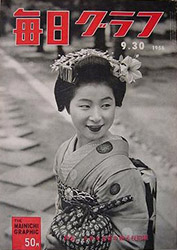The Pigeon Loft
Contents
(Scroll down or click on Links)
Endō Kamera-ten/ Sashin Yōhin
Shinano Kōki
Pigeon 35 Based Cameras
Pigeonflex Mystery Model
Pigeonflex
Pigeonflex IA
Pigeonflex IA Re-imagined
Pigeonflex I, IB & IC
Pigeonflex ID
Pigeonflex Automat
Serial Numbers
Outsourcing of Components & Maybe More
Alfa Optical Co. - Pigeonflex Look-alikes
Similar Components - Other Relationships
Tokiwa Seiki, a Late Pigeonflex Recruit
A Different History
Pigeonflex Lens Caps
Pigeonflex Ever-ready
Cases
Pigeon Lens Hoods
This Page
Originally, it had been my intention to ignore anything not made by Yashima/Yashica. This after all is the Yashica TLR site. However, I then thought that it would be interesting to compare models and to point out the differences that separate a Yashima Pigeonflex from a Shinano variety. There is also very little information about the non-Yashima made models and some collectors have both types so that was another reason to do something.
I started writing this page by following the conventional wisdom of Camera-wiki.org and Camerapedia that Yashima made the first Pigeonflex and Shinano was responsible for all the rest but looking at the models more closely, it became obvious to me that whilst Shinano's Pigeonflex IA has strong design links to Yashima's Pigeonflex and Yashimaflex, the model IA has nothing in common with the subsequent models I, IB and IC even though the specs are basically the same. They look like they have come out of a different factory. Which one? Based on design features and trim alone, the Alfa Optical Co. cameras are a very close match indeed. That's a radical idea in terms of accepted history but here is another even more crazy one. How about at least one more model, say from a completely different company again (manufacturer number four). The model name can be found in an obscure Japanese spreadsheet which suggests it is the ID. Well, it definitely exists, ups the specs and it was almost certainly made by Tokiwa Seiki.
Much of the information in Camera-wiki.org and Camerapedia has been interpolated from period advertising. Maybe in joining the dots, some dots have been missed? Further below is one more lot of advertising dots that has only been superficially investigated, suggesting the possibility of manufacturer number five, albeit, it would be the first one, i.e. before Yashima. Certainly, there are factual differences between quoted specs of cameras identified by the wikis and the examples found so the information in Camera-wiki.org and Camerapedia is not infallible. Sugiyama is of no assistance - he only identifies two models and has the dates back to front (see here).
This page examines the differences between Pigeonflex models and similarities with other maker's cameras in some detail. That is to both assist with identifying which model is which and also because what I am arguing has not been said before - I need to present a believable case so that the theory is more than just an interesting story. Additionally, there is evidence of some form of relationship between Alfa Optical Co. and Shinano and the links are strongest through Shinano's Pigeon 35. So, as well as focusing on TLRS not made by Yashima, a sub-page will forensically examine a range of 35 mm cameras not made by Yashima. As far as I am aware, as with Alfa Optical Co., no other source has claimed that Tokiwa Seiki is responsible for a Pigeonflex model before. However, that one is easier to support, I have snapped up the camera that largely presents its own case.
This page started as an exhibition of models but, as with the Yashima/Yashica TLRs, and other Yashica models, it is now a different interpretation of history than has been presented anywhere else previously (again, as far as I am aware).
History
To briefly recap what is reasonably accepted, Yashima Seiki Co., Ltd. produced its first camera in early 1953. This was marketed as the Pigeonflex by Endō Kamera-ten (Endō Camera Stores), which became Endō Sashin Yōhin (Endō Photographic Supplies) in June 1953. Also in June of the same year, Yashima changed its name to Yashima Kōgaku Seiki Co., Ltd. The change was reflected in the company name which appeared under “Pigeonflex” on the nameplate. In October 1953, it introduced a mildly revised version of the Pigeonflex under its own name as the Yashima Flex. Endō Sashin Yōhin then switched manufacturer to Shinano Kōki, a little known company which had already produced the Pigeon 35 camera. According to Camera-wiki.org, Yashima made Pigeonflexes were advertised until May 1954 but as noted below, the photo in the ad was already out of date by the middle of 1953 and further down is an ad for the Pigeonflex IB featuring the photo of a IA. So that May 1954 date is probably quite meaningless.
Endō Kamera-ten/ Sashin Yōhin
Below is document found with a Yashima Kōgaku Seiki Co., Ltd. Pigeonflex (the photo on the cover is the earlier Yashima Seiki Co., Ltd. version) and its box (rather than a brochure/flyer, the instructions under the specs suggest how to fold it for a shop display so probably a marketing prop). The name and address on the bottom translates as Endo Photographic Supplies Co., Ltd. 3-7 Kyobashi, Chuo-ku, Tokyo:
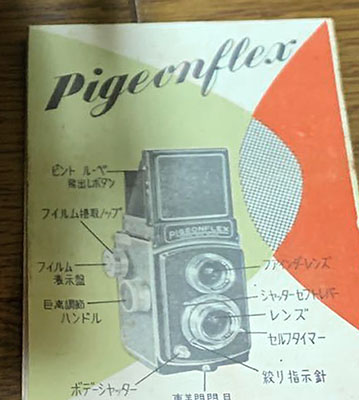
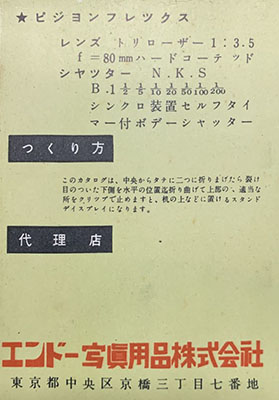
(detail from larger web images)
Not much is known about Endō apart that it was a marketing distributor that first came to notice in about 1951 and continued with “Pigeon” named products until about 1956. Certainly, there is no evidence of Endō producing anything itself.
The Pigeonflex in the Endō Photographic Supplies ad on the right below is clearly the earliest Yashima made version with “Yashima Seiki Co., Ltd.” under the Pigeonflex name on the nameplate. This particular ad appeared in Asahi Camera in 1954 (we have to accept that the images in both ads may be somewhat outdated, this Pigeonflex was made before Yashima's name change in June 1953, or earlier). Camera-wiki.org and others have used this ad as evidence to claim that the Yashima made Pigeonflex was the first version. Yes, first out of Yashima and Shinano but Camera-wiki.org has only identified two makers, not many. To put this ad into context, the enlarger seems to be part of an expanding range of accessories and peripheral equipment (see later ad further below). The logo at the bottom appeared on the hood of the following Shinano Pigeonflex IA, lens cap of at least the Pigeonflex IB and possibly most post-Yashima Pigeonflex ever-ready cases.
However, the left ad appeared in Asahi Camera in the previous year, 1953, which clearly makes its Pigeonflex older, also reflected by the Endō Camera Stores name at the bottom:
(Ads are from a Japanese website featuring manuals and other downloadable material)
(Click on ads for larger versions)
Camera-wiki.org was aware of the earlier ad but dismissed it with “an early advertisement shows a decorative silver plate behind both lenses”, implying that it was still Yashima made. However, in addition to the large chrome viewing lens trim piece which extends to the sides of the taking lens, there is no maker name under “Pigeonflex”, the focusing hood has a sports finder, the strap holders have arrow-like ears to secure the neck strap and the metal plates are shorter, the locking lever has a curled up front piece rather than being flat and there is no film type reminder on the film winding knob which has a double row of knurling instead of single row. It is also ¥200 more expensive at “about” ¥15,000. However, the lenses are still Tri-Lausars and the shutter an NKS. Whilst it is possible that it is an unknown Yashima version, in my view, it is different enough to be more likely from an unknown maker.
Camera-wiki also tells us that the Pigeon Six folder at the top of the left ad was announced in magazines dated January and March 1953 and advertised from March to May of 1953 but there are no announcement dates for any Pigeonflex models, only that the earliest found ad is from March 1953. So dating the mystery model with any accuracy is not possible. Certainly, the evidence is that Yashima started making its Pigeonflex towards the beginning of 1953.
Whilst it may seem that the Shinano made Pigeon 35 in the left ad seems more modern than the one in the right, it is a Model III (released in 1952 according to Sugiyama), the third main version of the top model and priced at ¥15,500. The one on the right is a similar vintage budget Model J costing ¥7,900. The similar chronology of the two models is confirmed by this item from the April 1954 first edition of “Orient Photography”:
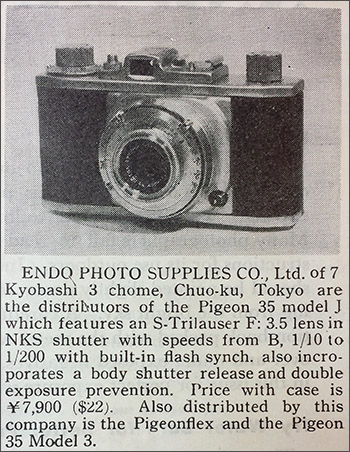 (Scan courtesy of Chris Whelan)
(Scan courtesy of Chris Whelan)
This double page ad is from Asahi Camera in 1955. It features the later Pigeonflex IB and budget Pigeon 35 Model JII. Added to the earlier enlarger is a range of darkroom equipment plus other accessories.
(Ad is from the same Japanese website noted above)
(Click on ad for larger version)
It is evident that Endō's Pigeon brand products were either simple re-branding exercises or, in some cases perhaps, commissioning of items from other companies. For example, the Pigeon 35 camera seems to predate what is presumed to be Shinano's own Lacon brand version so was perhaps designed for Endō. The Yashima Pigeonflex appears to be the product of Yashima getting into camera production just to supply the one model to Endō. The Pigeonflex IA seems to have been in a somewhat similar situation. Before this, there is nothing to suggest that Shinano had a TLR in its armoury and it seems unlikely that it sold a version of this model itself or to anyone else. On the other hand, the later Pigeonflex I, IB, IC and ID have direct links to existing models. Whether this was a change in Shinano's operational model or merely reflected the reality of a difficult market for the TLR makers is hard to know.
We can also speculate that Endō was not fussed about continuity of manufacturing partners. It is accepted that it used Shinano for the Pigeon 35 models, TLR maker Tougodo for the Pigeon V and 5B 35 mm models, Yashima for the Pigeonflex and Shinano for the Pigeonflex IA. The evidence now also suggests that it used Alfa Optical Co. for the Pigeonflex I, IB and IC and Tokiwa Seiki for the Pigeonflex ID and Automat (advertised at least). And there is also the first advertised Pigeonflex of unknown ancestry.
Shinano Kōki
Shinano was a small camera maker which is known to be responsible for the basic fixed-lens 35 mm Pigeon 35 marketed by Endō from 1951, the Pigeonflex IA TLR marketed from March 1954 and “perhaps” (according to Camera-wiki.org) the Pigeon Six folding camera which was advertised in the early part of 1953, see above. Endo is known to have earlier distributed at least two obscure 4.5 x 6 “semi” folders before the Pigeon brand came to the fore and given the number of manufacturers it seems to have courted, I think that the Shinano link is quite tenuous. Regardless of origin, the camera probably did not have any standout qualities in a crowded market.
The same could be said about the Pigeon 35 but this seems to have been a little more successful. Similar, but slightly later, versions of the camera were sold as the Lacon by the Lacon Camera Co. (presumed to be a Shinano owned) and a late type of the Lacon was also marketed as the Saga. Although little is known about Shinano with very little information on the net, Pigeon 35 and Lacon varieties do surface for sale from time to time. They elicit little interest - there is nothing in their specifications to excite the photographer or historian but there must have been a few made - their price point probably hit a sweet spot with consumers, at least for a little while.
What does this tell us about Shinano as a Pigeonflex TLR maker? Probably not an awful lot. My interpretation would be that Shinano was a small, relatively low volume enterprise focusing on the low cost/ low margin end of the crowded mass market, i.e. not very profitable place to be. Buying in lenses and shutters, it probably had some metalwork capabilities in-house but how much and what, if any, was contracted out is not possible to know. Unlike with TLRs from small makers, it is unlikely that there were many “off-the-shelf” body parts for the Pigeon 35. However, Shinano would probably have taken a conservative route with a new TLR with minimal investment in design and new production capability and so therefore using existing components, perhaps bought in from Yashima or from Yashima's suppliers, as much as possible. Endō would have been looking for some continuity of design as well. The fact that there are great similarities between the Pigeonflex IA and the Yashima Flex, noted below, is perhaps not surprising. The fact that there are no obviously shared parts between the IA and similarly specified I, IB and IC is quite unexpected.
Pigeon 35 Based Cameras
In my research, I have collected more information about these cameras than is available anywhere else so it is presented here for anyone interested:
(Click on name or image)
Pigeon 35
(Image courtesy of Chris Whelan)
The Pigeon 35 and related models also give some hints about Shinano as a camera maker and marketeer but more importantly, they have relevance to tracing TLR heritage. Camera-wiki.org has suggested a link between the Shinano Pigeon 35 and the Cosmo 35 and others made by the successor company to TLR maker Alfa Optical Co. The physical evidence appears to support that. In other words, whilst I will be trying to demonstrate that the Pigeonflex I, IB and IC TLRs have more in common with Alfa Optical Co. models than Shinano's IA, there also appears to be a connection between the two companies.
The Pigeon TLR Flock (Models)
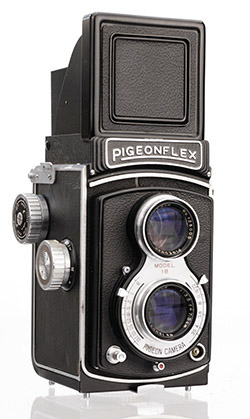
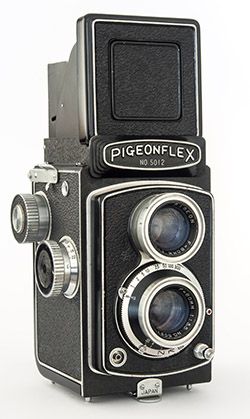
First camera is a Yashima made Pigeonflex (this with Yashima Kōgaku Seiki Co., Ltd. nameplate type, earliest has Yashima Seiki Co., Ltd. as the maker), second is a Shinano made model IA (image courtesy of Sandu Baciu), third is either a model IB or IC (confusion surrounding its Pigeonar lenses) probably made by Alfa Optical Co., (Hugo Studio photo of contributor camera) and fourth is a model ID (likely name) probably made by Tokiwa Seiki. Not shown are the first advertised version (maker unknown), the model I (economy version of the IB/IC from the same period) and Automat (advertised but no actual camera found yet, perhaps related to the ID).
The basic specs of the first three cameras pictured are very similar. Ads for the three list the prices for the Yashima Pigeonflex at ¥14,800 (see link above) and the IA and IB both at ¥15,000 (see ads below). Against these, Yashima introduced the Yashicaflex model A-II in late 1954, which takes away the self-timer and slow speeds but adds auto-stop winding, priced at ¥9,500, and the Yashicaflex model C in the second half of 1955 with self-timer, a full range of speeds to 1/300, auto-stop winding and Bay 1 filter mounts for ¥11,500. The similarly featured Yashicaflex model S with added exposure meter, but with no doubt less developed production techniques, had been available from 1954 for ¥20,000, a very reasonable premium over the original Pigeonflex based Yashima Flex and Yashica Flex model B, both priced at ¥15,000. Yashima's A-II and C pricing was stunning in comparison to all the earlier cameras and is the first real evidence of the success of Yashima president and co-founder Yoshimasa Ushiyama's stated aim of increased automation, high production volumes and affordable prices. Clearly, the other Pigeonflex makers, and other TLR makers generally, were on notice that they were going to be losing market share to Yashima as well as to the move to 35 mm.
Below is a Pigeonflex IA ad and two IB ads from Japanese publications from probably 1954. The colour and low resolution match the originals (shown larger than their physical size). To me, it seems that the photo of the camera in the first IB ad (the smaller of the two) is still of the IA - it has a hood logo and rim-set shutter as far as I can tell.



Models & Specifications Table
The full range of variations/models in the table below are somewhat documented but often incorrectly. I have found multiple photographic examples of most, the exceptions being the first one with only a pictorial ad, the last with a descriptive ad and single examples of the second and third last cameras. All are basic 120 TLRS following the Rolleicord body design (but not feature set) very closely. All, except the ID, and presumably Automat, and maybe even the first one, have manual film advance by red window and all have plain filter mounts (Automat is unknown) and from a distance, look similar as most Japanese TLRs from the period do.
(Click on table for larger view)
Note 1: The specs for the Pigeonflex I, IB and IC are based on information from Camera-wiki.org, also contained in Camerapedia, both linked above, as well as the photographs that can be found on the net, in particular Japanese auction sites, and Sandu Baciu's photographs of his model IA. Note that the information has been corrected and added to based on photographic and other evidence as stated below and elsewhere. Note also that Camera-wiki.org claims that the Tri-Lausar viewing lens on the model IB is f/3.2 but it is almost certainly an f/3.5 on all examples - I have seen photos of at least ten IB cameras from early to late versions (see below). Also, I can find no f/3.2 Tri-Lausar viewing lenses on any other cameras (the rare Autoflex made by Tokiwa Seiki has a f/3.5 “Tri-Lausar Anastigmat” taking lens but an unnamed f/3.2 “Viewer Anastigmat” whereas the matching Tomioka viewing lens is usually called “Tri-Lausar Viewer”, as it is on Tokiwa Seiki's other cameras with Tri-Lausar lenses and f/3.5 viewing lenses).
Note 2, Pigeonflex IC: Camera-wiki.org claims that the model IC “is the same as the IB but with Pigeonar lenses (again 80mm, f/3.2 and f/3.5)”, noting that the IB viewing lens aperture is almost certainly incorrectly identified by Camera-wiki.org in the first place. A model with IB faceplate has recently turned up for sale with very clear photos (see Pigeonflex IC) and its lenses match the budget Pigeonflex I model, i.e., it has Pigeonar 75 mm lenses with a f/3.5 viewing lens. It has a unique textured nameplate, suggesting that it may be a later version than the found IB examples. Whether it was actually called a “IC” is open to conjecture but I will continue to use that model name for convenience and the fact there appears to be a ID.
Note 3, Pigeonflex ID and Automat: Although almost undocumented, there is evidence for both, see “Mystery Models” below. What is probably a Pigeonflex ID, has now been found, see Pigeonflex ID.
Note 4, Dates: The greyed-out dates are based on the Yashica/Kyocera document referenced by several sites for the Yashima Pigeonflex and magazine advertising dates for the other models as referenced in the Camera-wiki.org and Camerapedia entries. Whether they are an accurate reflection of production start and finish is not known but they are probably in the ball park. The circa dates (c1955 and c1956) are best guesses by me. Note that the June 1956 Popular Photography report on the Chicago Trade Show advises that the display by the Japan Camera Service and Information Centre of New York still lists the Pigeonflex as an “available model for export to the United States” and that the Automat still appears to be advertised in September 1956 in Japan (see below).
Mystery Models
On sale (as at 29 November 2014) on a Japanese website (not Yahoo Japan) was a magazine-like daily dated 30 September 1956. The contents are listed and include a 1/3 page ad for “Endo photographic supplies Pigeon flex automat” (Google translation, screen-shot further below). In case that you are thinking that is just wishful thinking on the part of Google, both Camera-wiki.org and Camerapedia link to an archived Japanese spreadsheet listing all Pigeonflex models, https://archive.md/YUiXR. The last camera in the list is a model with crank wind and auto stop film winding translated as the “Automat A”. The camera before it is claimed to have auto-stop (i.e., no red window) and a Copal MX shutter with 1/300 top speed. It is called the “D-Type” Unlike with the other models, no maker is listed for either and the lenses translate as neither Tri-Lausar (“Roser”) nor Pigeonar (“Pijona”). They translate as “Piokoru” (possibly a bad machine translation of “Pigeon”) for the first and either as “Etaru” or “Ettal” for the second. I can now confirm that I have acquired a version of the “D-Type”, as machine translated, which in keeping with the existing nomenclature, I will refer to as the model “ID”. Note, it has an NKS-SC shutter with the higher 1/300 top speed, not the Copal with 1/300 listed in the spreadsheet. See Pigeonflex ID further below (also pictured above).
As the 1D exists, I think that it is highly likely that given the evidence of the 1/3 page ad, the “Automat A” does too. In line with the ad, I'll refer to it as the “Automat”. I think that it is also highly likely that they were simply rebadged models from a previously unidentified maker, certainly not Shinano and most probably not Alfa Optical Co, another company that I have proposed as a player. The evidence points to Tokiwa Seiki - that will be explained further below.
There are many problems with the Japanese spreadsheet, which is probably the reason that neither Camera-wiki.org nor Camerapedia seem to take it too seriously nor display the contents. The errors are such (wrong lenses, shutters, maker) that I can't directly link any model in the spreadsheet, except the ID, to the photographs found so far. Nevertheless, the claims for the existence of advanced models now have independent support.
Pigeonflex Mystery Model
The First Advertised

The image is adjusted and upscaled from the 1953 Asahi Camera ad above, Camera-wiki says the ad is from March. Camera-wiki simply dismisses the differences with the typical Yashima version with the statement “decorative silver plate behind both lenses”. As noted earlier in more detail, the differences are numerous and include the focusing hood, strap holders, several features of the film winding knob and the curled front of the back locking lever. There are many more differences between this and the next version than in Yashima's creation of the Yashima Flex from the Pigeonflex, in fact the first Yashimaflex version didn't yet feature a sports finder as this one seems to have.
Whether the advertised camera was released or not, I suspect that it is not an early version of something made by Yashima.
Pigeonflex
The Yashima Made Original, or maybe Second One
The Yashima made Pigeonflex is discussed in 66 Models. It and the mystery model above share lenses and shutter but none of the later Pigeonflex versions feature the plain NKS shutter and only the model IB features their Tri-Lausar lenses. The Yashima Pigeonflex has a side mounted flash sync socket and so presumably does the mystery model (not evident in the photo) but the Shinano IA and later models have the sync socket low down on the front. The Yashima Pigeonflex has no accessory shoe (I have found three with shoes, one earlier, two later examples, no doubt all added afterwards), the mystery model is unknown but all the others do. Three trim items that the Yashima Pigeonflex does not share with any later Pigeonflexes but does share with the subsequent Yashima models are the style of the film type reminder on the film winding knob, the design of the rear red window and the detail of the back locking mechanism on the camera base. It doesn't share film type reminder or locking lever with the mystery model either but the red window design is unknown.
This Yashima Seiki type is one of the earliest in my database. The leatherette is missing from the focusing hood, as with the example below, and the magnifier release button is also missing:
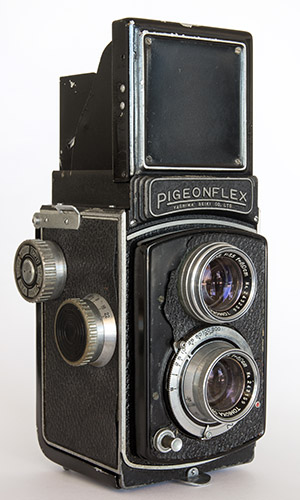
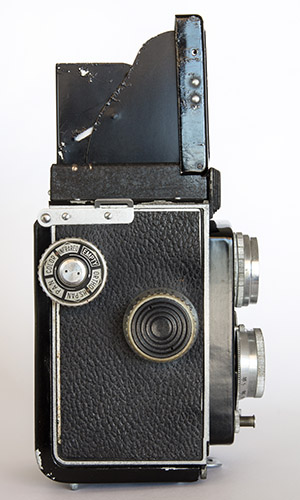
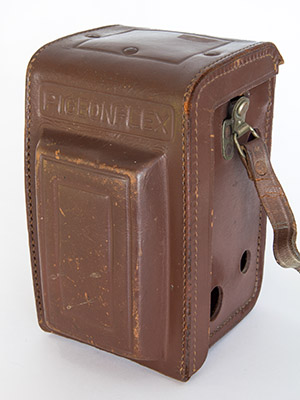
This is one of the earliest Yashima Kōgaku Seiki types with first type magnifier still:
 010.jpg)
 013.jpg)
 016.jpg)
 017.jpg)
 018.jpg)
 028.jpg)
For Yashima Pigeonflex case variations, see Camera Ever-ready Cases. Later Pigeonflex cases are different, see Pigeonflex Ever-ready Cases below.
Below is a later type Yashima Pigeonflex with less curve to the Pigeonflex name and its underline and it has the square shaped magnifier with release towards the front of the focusing hood.
(Images courtesy of Sandu Baciu)
Below is the last style Yashima made Pigeonflex without maker name (square magnifier in the up position in the left image). Note that the following IA, I, IB and IC models made by others again feature the earlier more curved nameplate style:
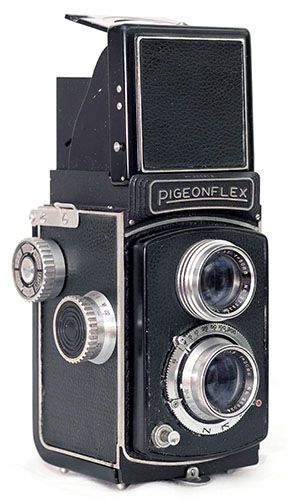
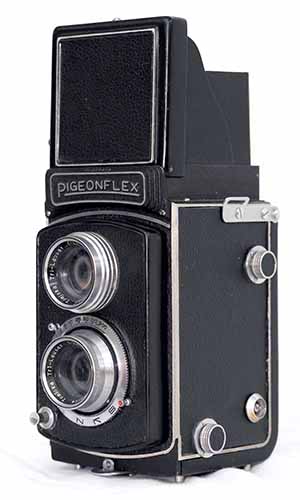
(Images courtesy of Rick Sweeney)
Pigeonflex IA
Shinano Maintaining the Style
This was Shinano's immediate replacement for the Yashima model and the closest in appearance to the original. The first and commonly found version has an 80 mm Pigeonar Anastigmat f/3.2 viewing lens and clearly marking it as a Shinano product, a “SHINANOKōKI PIGEONAR” f/3.5 taking lens (see also Lacon 35 mm camera):
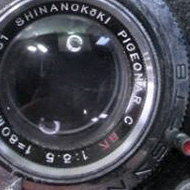 (Detail from larger web image)
(Detail from larger web image)
There is also a later version with Excelsior lenses (see below).
The IA's NKS-TB shutter is also seen on earlyish Yashima Flexes, but not the first ones which continued with the earlier plain NKS. It has a sports finder similar to later Yashima models and Endō's Pigeon logo on the focusing hood. Barry Toogood had a picture of one on his TLR-Cameras.com site that doesn't have the logo but that could also be due to renovations at some point in its life.
As well as the differences such as the front sync, accessory shoe, sports finder and other items noted in comparison to the original Pigeonflex, note that the rear of the focusing hood blind (Yashica terminology) seemingly has more in common with the Rolleicord III and IV appearances than Yashima models but in fact it is almost identical to the the first Yashima Flexes with NKS shutter still (not the very first Yashimaflex type with Pigeonflex hood still). But there are other similarities too. The general appearance is similar, the focusing knob distance and depth of field scales appear the same and the black focusing knob end cap on the one below, and one other late example, appears identical (also shared with the following Excelsior lensed versions below). On earlier examples, the caps are silver of a similar design. Yashima Pigeonflex on left, Shinano 1A variations centre and right:
 009.jpg)
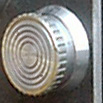
(Centre image courtesy of Sandu Baciu, right is from larger web image)
The film winding knob appears somewhat similar, although the six reminder flags are slightly different and in a different order on a silver background instead of black (an almost identical type is found on one example of the Alpenflex - these are likely to be bought-in items). The red window arrangement is almost identical to the Yashima model except that the window itself is circular instead of diamond shaped. This is very much a copy with some minor updates to take over from the original model. It certainly looks like many of the parts and/or suppliers could be shared with Yashima models but we don't know that - Shinano may simply have been going for the overall appearance, it didn't have an original design to offer. Note, the aperture scale on the taking lens bezel is silver (or white) on black on the example below, as on all of the second half 1A examples in my database - on the first half, it is black on silver:
Images courtesy of Sandu Baciu
Whether the bodies of the Yashima and Shinano cameras are the same is hard to know - they were all patterned on the Rolleicord so even two different foundries would produce die cast bodies looking much the same. The different positions of the accessory shoes and the three screws in the spool knob backing plates in the comparison a little further down are inconclusive. These are not things that you expect to get changed just to make a camera look different but on the other hand, Yashima and/or Shinano may have just started with unmachined blanks. The base of the camera back is different because of the extra design flourish as is the appearance of the locking mechanism but the locking mechanism still operates the same way and has the same broad style of the original Pigeonflex - the source still could be the same, and/or it has been chosen to provide some visual continuity.
All found Yashima Pigeonflex serial numbers are six digit, all others are five digit. Early Shinano credited versions seem to have the serial number under the Pigeonflex name rather than on the top edge of the nameplate and later cameras seem to have it on the top edge, although the very earliest IA also has it on the top edge. My database includes model IB examples of both variations - later examples revert to the top edge. So in summary, the IA started with serial number on the top edge, almost straight away changed to under the name and then early on with the IB model, the serial number moved back to the nameplate top edge. One unusual thing about IA and ID lens serial numbers is that they are four digit, all others are six digit.
Comparison to Yashima Flex
The Pigeonflex IA probably has more in common with the early Yashima Flex than the original Yashima Pigeonflex:
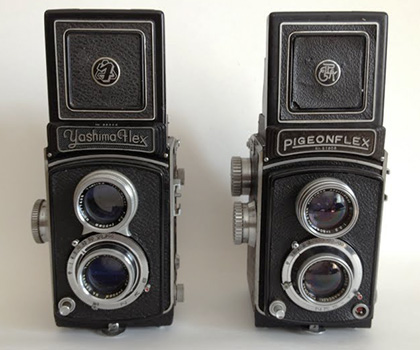

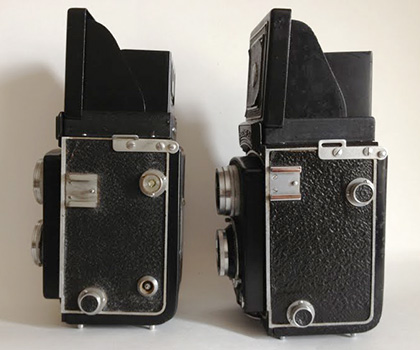
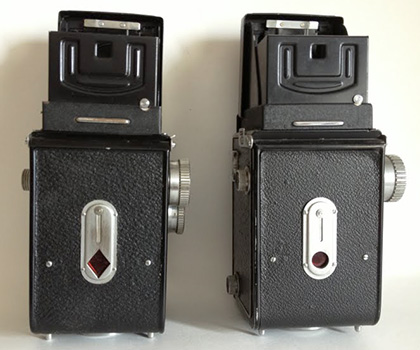
(Images courtesy of Sandu Baciu)
However, note that the coarse knurling on the Pigeonflex IA knobs is more like the original Pigeonflex. Note also the different positions of the three screws in the film spool backing plates. Both are different to the following models I and IB/IC. The hood assemblies appear almost identical (except for the height of the chrome bar) but this Yashima Flex version existed only briefly between the original Pigeonflex style on the earliest examples and the style that would be standard on Yashima models for the next few years - see Yashimaflex/ Yashima Flex.
Late IA Version with Shinanokōki Pigeonar Viewing Lens
When I saw my first example of a 1A with Shinanokōki Pigeonar f/3.5 viewing lens instead of the usual Pigeonar Anastigmat f/3.2, I thought that someone had replaced the viewing lens with a taking lens for some reason. Then I saw the second, their serial numbers are 514xx and 515xx, towards the end of the Pigeonar fitted series but not right at the end. The other unusual thing about both the taking and viewing lenses on the two cameras is that they are 5 digit in the range 168xx to 169xx whereas all other Pigeonar lenses are 4 digit and range from 54xx to 67xx. It seems to me that these are most probably original factory fitments.
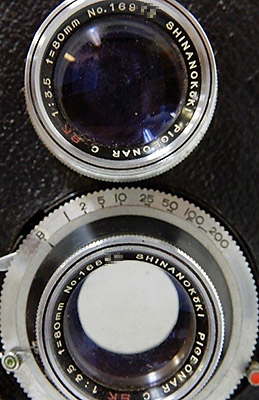 (Detail from larger web image)
(Detail from larger web image)
Late IA Version with Excelsior Lenses
Three examples have been found on Japanese Auction sites fitted with unknown “Excelsior” lenses. Typical IA examples with Pigeonar lenses top out at serial number 516xx, these late examples are 517xx, 51794, belonging to correspondent Rick Sweeney, and 518xx.
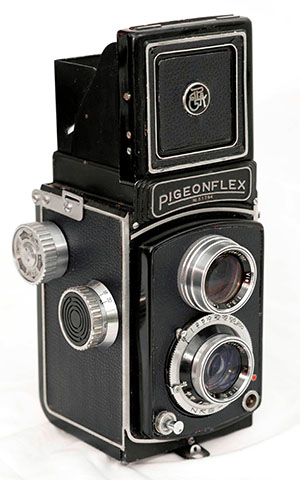
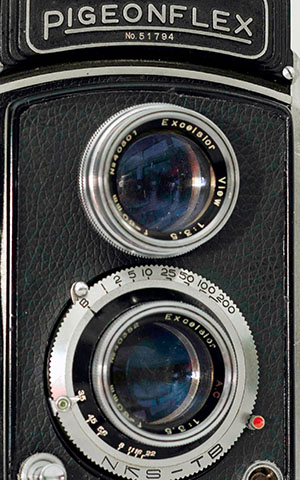
(Images courtesy of Rick Sweeney)
The lens' serial numbers are 5 digit instead of the usual 4 digit. The viewing lens is marked “View Excelsior” and the aperture is f/3.5 instead of the usual Shinano Pigeonar Anastigmat's f/3.2.
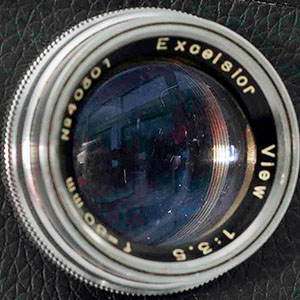 (Image courtesy of Rick Sweeney)
(Image courtesy of Rick Sweeney)
All three have the black focusing knob end cap of the last of the earlier IA types but in other respects are the same as the others. Almost. The last one has a locking knob variation. The tripod mount itself is the same as the majority of examples (disregarding the number of rings - this one is like Sandu's above but at least a couple have four close-set black rings near the centre, probably earlier) but the locking lever with folded tip is quite different compared to the usual straight types with a flat rounded end including the other two Excelsior examples.
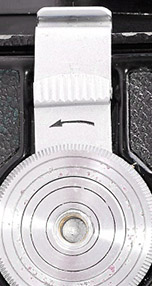
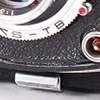 (Detail from larger web images)
(Detail from larger web images)
Pigeonflex IA Re-imagined
Real or Fantasy?
I saw this for sale on a Japanese auction site. It would be easy to dismiss it as a a parts based fantasy camera but there are aspects that make it hard to explain away in those terms. I'm not sure whether it is earlier or later than the typical Shinano model IA - some features suggest earlier, some later. I also have no firm views about whether it is Shinano made, or a very close IA copy by some other maker, just a guess. I'll describe the camera, add some photos and you decide:
Shutter: Plain NKS as on the Yashima made Pigeonflex and first Yashimaflex/Yashima Flex examples. The black aperture scale background is similar to both Yashimaflex/Yashima Flex and Shinano IA cameras. However, the lens bezels match the detailing of the Shinano IA with NKS-TB shutter. Therefore it looks like an earlier version of the IA.
Lens: Unusually, the viewing lens retaining ring is completely plain without any text at all. The taking lens retainer is marked
“VIEW CHIVER Anastigmat 1:3.2 f=80 No. 66xx”. Obviously, this is meant to be the viewing lens (lenses probably swapped). The style of text and description is very similar to Shinano's viewing lens “PIGEONAR Anastigmat 1:3.2 f=80 No. xxxx”. Specs are identical and match typical IA lenses. Both use 4 digit serial numbers for the lenses. The only camera I have found the View Chiver lens on is the Queenflex where it is paired with a “YOSHINONE” taking lens. Models seem to be fitted with either these or Tri-Lausar lenses. The unknown maker name, Hasegawa Optical Co., appears under the Queenflex nameplate on many examples as it also does on Chesterflex TLR Models. There is no obvious link to Shinano, or the other features of this Pigeonflex IA, so it is possible that the lens/es was/were transplanted at some later point in the camera's life.
Focusing hood: The complete assembly seems to match the typical Pigeonflex IA hood. The logo is missing but has clearly been there.
Nameplate: The nameplate is the typical Pigeonflex IA/I/IB style with the serial number under the name. I can't make out the actual number but it is 4 digit whereas all found IA/I/IB examples have 5 digit numbers. Therefore it is likely to be a unique nameplate (rather than borrowed from some other camera) and appears to be earlier than other IA examples.
Body: Externally, looks like a typical Yashima Pigeonflex or Shinano Pigeonflex IA or Alfa Optical Co. (possibly) I/IB/IC body except that the alignment of the three screws in the spool knob backing plates is different to the others and unlike the other Pigeonflexes (except the later ID), the shutter release is left handed and the flash sync is on the opposite side. Internally, the “landing pads” for the pressure plate are not machined like the Yashima and Shinano models and therefore the body looks more like the I/IB/IC type but whether the same is not possible to tell from the low resolution photos.
Accessory Shoe: The accessory shoe is unlike any other Pigeonflex type and different to that used on other models by makers linked to the various Pigeonflex models. It is somewhat similar to the Minolta Autocord type but the centre spring is wider than commonly found on those and also unlike those, the screw holes are hidden in the slots presumably requiring fixing from behind the side cover before it is secured to the camera (three of the four holes are visible in the photo but no screw heads).
Flash sync: It is the only Pigeonflex before the Tokiwa Seiki made Pigeonflex ID to be found with a PC type flash sync socket instead of the earlier ASA. This suggests that it is later than the typical IA.
Camera back: At first glance, the camera back looks like a typical IA type . It has the Yashima Pigeonflex/Shinano IA style red window assembly with the IA round window. The bottom of the back has similar pressed ridges to the IA but closer inspection reveals them to be different to the IA and Yashima made models and also later models. On the other hand, the locking mechanism appears to be pure Yashima Pigeonflex featuring the very earliest plain arrow without feathers (the typical IA mechanism operates the same way and could be based on Yashima's version). The pressure plate inside is unique. It looks identical to the original ribbed Yashima type first found on Yashima Flex examples (note, not Pigeonflex which was plain) except that the red window aperture is circular instead of diamond shaped - typical IA examples are similar except that the IA reinforcing ridges run along the plate instead of across the plate as on this and Yashima models. Hard to say earlier or later than IA but the Yashima Pigeonflex style lock suggests earlier.
Knobs: The film winding and focusing knob detail appear typical IA in the low resolution images.
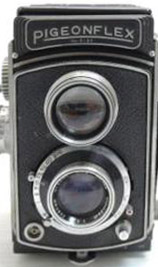
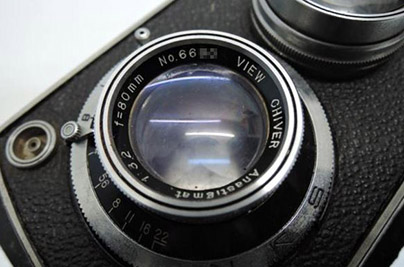
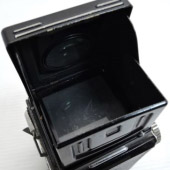
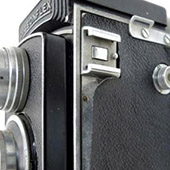
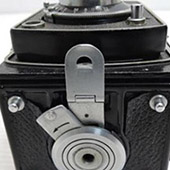

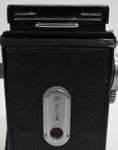
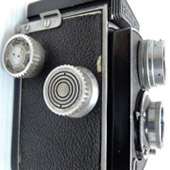
(Details from larger web images)
Overall, there are elements which suggest that it is an earlier camera but the PC instead of ASA flash sync is a strong indicator of a later camera.
This is my guess. Shinano took over from Yashima and produced a camera that owed much to the original, perhaps even using the same suppliers of some parts. For an unknown reason, production by Shinano stopped before the following model(s) were ready. Another maker stepped in and tried to continue IA production using whatever parts/suppliers were available and substituting only if there was no other option. Therefore there are some typical IA parts and some earlier style Yashima parts added to a different body featuring components like the PC flash socket and left-handed shutter release. It must have been very short-lived as the IA itself lasted barely 6 months.
Pigeonflex I, IB & IC
A New Look - Going Forward by Looking Back
The Models
These three models are all closely related to each other and follow the IA, presumably replacing it. Whereas the basic specs remain similar, trim-wise, these cameras look quite different to the earlier models. For a start, the Pigeon hood logo introduced with the IA is now gone. Originally, I thought that Shinano was trying to recapture the appearance of the pre-war Rolleicord I and II but further evidence suggests that the models may have been made by Alfa Optical Co.
The Pigeonflex I is a budget model and by Camera-wiki.org dates, seems to have been released a month earlier than its companion and slightly more upmarket IB. The IB is the true successor to the IA but is largely based on the I whilst the IC is a IB with Pigeonar lenses. The IB and IC feature a faceplate cover over the shutter similar in style to later Yashima models with Bay 1 mounts and closer still to the later Yashicaflex A-III, A2, A (new model) and Yashica B with plain filter mounts.
The model I loses both the self-timer and sports finder and is fitted with Pigeonar 7.5 cm lenses with f/3.5 viewing lens. Note that these Pigeonar lenses are different to the IA model - the length is “7.5 cm” against “80 mm” and there is no mention of “Anastigmat” or the maker name “SHINANOKōKI”. The shutter is usually the little known “S. Luna” of the same specifications as the NKS type (see Alfa Optical Co. below and Pigeon 35, this shutter may be made by Toyo S.K. Co. which may stand for Tōyō Seiki Kōgaku, maker of Princeflex and Elbowflex TLRs - Camera-wiki.org). Three examples are fitted with “TSK” shutters also marked “TOYO S.K. CO.” (in other words, the S. Luna and T.S.K. shutters are probably made by the same company).
The model I focusing hood loses the sports finder of the IA and IB/IC. Although it doesn't have the IB faceplate covering the shutter, it does have the “coat tail” trim somewhat similar in style to the Yashima Flex and Yashica Flex model B but quite different in execution and appearance:
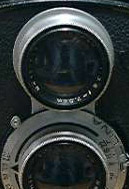
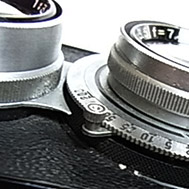 (Detail from larger web images)
(Detail from larger web images)
Further below, I note that the trim and lens bezels appear similar to an Alfa Optical Co. example.
As the premium model, the Pigeonflex IB retains the self-timer and sports finder. The model name, “Model IB” is displayed between the lenses and “PIGEON CAMERA” is displayed under the taking lens. The shutter specs are the same as for other models but the manufacturer is not identified. Whilst it could be an S. Luna, S. Luna and T.S.K. shutters have the self-timer lever (where fitted) at the 3 o'clock position and the aperture scale at the bottom, but the IB/IC has the self-timer at the bottom and the aperture scale on the side. However, that is dictated somewhat by the shutter cover plate so it is possible that the shutter was adapted to suit. The lenses are 80 mm Tomioka Tri-Lausar, their first and only appearance on a non-Yashima made Pigeonflex model, with f/3.2 viewing lens according to Camera-wiki.org. However, I have already noted under the table at the top that I believe it is an f/3.5 - there are clear photos of three cameras with the f/3.5 (plus other photos which look like f/3.5) and I cannot find any examples of a Tomioka f/3.2 Tri-Lausar viewing lens on any TLR model.
According to Camera-wiki.org, the model IC is the same as the model IB except that fitted with Pigeonar lenses of similar specification to the Tri-Lausars of the IB. As noted in Models, I believe that Camera-wiki.org is wrong in regards to both the model IB Tri-Lausar viewing lens and the specs of the model IC Pigeonar lenses. The camera below clearly has Pigeonar 7.5 cm (75 mm) lenses and a f/3.5 viewing lens (same as model I). I think that someone has made an (incorrect) assumption that the 80 mm Pigeonars with f/3.2 viewing lens on the Pigeonflex IA would at least be equaled on later models (I think that apart from the “Pigeonar” part of the name related to the Pigeon brand, there is no connection between the lenses):
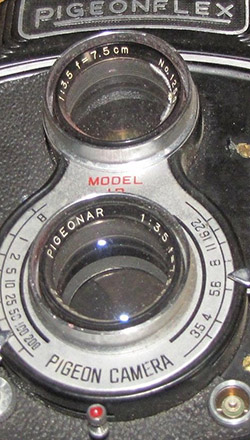 (Detail from larger web image)
(Detail from larger web image)
Camera-wiki.org also claims that the model was advertised only once and may not have actually made it to market. I am assuming this camera is the model IC even though the faceplate is still marked “Model IB”. Whether this version was officially called the IC, regardless of the faceplate, or whether somebody has called it that to differentiate it from the model IB with Tri-Lausar lenses, is unknown. However, I am satisfied that in some form, the version existed and was sold. Given the confirmed existence of what has been referred to as “D-Type” in one translated document, presumably actually called the “ID”, the IB with Pigeonar lenses was probably indeed known as the IC but as there is still some doubt, sometimes you will see me refer to the IB and IC collectively as the “IB/IC”.
Trim
Obvious changes compared to previous models (faceplate trim, see above):
(I have noted similarities to Alfa Optical Co. examples. At the top of the page and this section, I indicated that I think that this company's models form the foundations of the models I and IB/IC - this will become clearer in Outsourcing of Components & Maybe More further below.)
- The Pigeon hood logo introduced on the model IA is deleted on all three new models.
- The general style of the focusing hoods is changed from the Yashima Flex and Pigeonflex IA type to a new style found on several other makes of Japanese TLRs (discussed further below) including Alfa Optical Co. examples. Features of the new hoods include:
- A clip arrangement for positive securing of the hood in the same style as the Rolleicord I and II (the clip isn't there on late IB examples and the IC below) replaces the parallel bars on the rear of the focusing hood (previously similar to the Rolleicord III and Yashima Flex and later models):
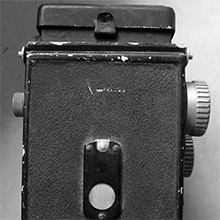 (Detail from larger web image)
(Detail from larger web image) - Revised hood blind (typical model IB shown, slightly revised late IB and IC are further below, the model I is similar to the IB but without the hole for the sports finder):
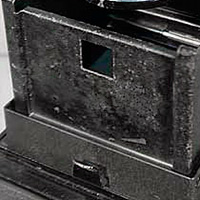 (Detail from larger web image)
(Detail from larger web image) - The focusing magnifier is new too (late IB examples and the IC below are different):
 (Detail from larger web image)
(Detail from larger web image)
- A clip arrangement for positive securing of the hood in the same style as the Rolleicord I and II (the clip isn't there on late IB examples and the IC below) replaces the parallel bars on the rear of the focusing hood (previously similar to the Rolleicord III and Yashima Flex and later models):
- New locking knob on all three which is not dissimilar to (but certainly not the same as) the later Yashima type introduced in the middle of 1955 but in fact is identical to one of the types found on some Alfa Optical Co. examples. Two model Is are different (see Pigeonflex I Images below) but are also of a type found on some Alfa Optical Co. Cosmoflexes as is the basic type found on the earliest model IB:
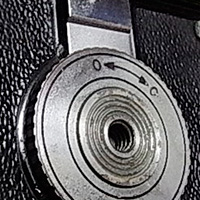 (Detail from larger web image)
(Detail from larger web image) - New red window assembly - although it remains in the same position (see also above), this looks identical to that found on the base of early Rolleis for setting the film start and quite a few Japanese TLRs (including Alfa Optical Co. examples), both on the camera bottom for film start and on the back when used for film advance by red window:
 (Detail from larger web image)
(Detail from larger web image) - Change of the focusing knob depth of field scales to early Rolleicord style white writing on a black background with early Rolleicord style black back-plate. The film reminder on the film wind knob appears to be cruder in design with a simple screw retainer but again, these both appear identical to some Alfa Optical Co. examples:
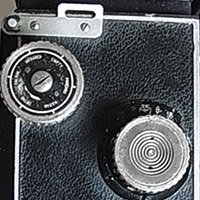 (Detail from larger web image)
(Detail from larger web image) - The strap holder plate kicks up at the hinge position like the early Rolleicords whilst on the Yashima Pigeonflex and the Pigeonflex IA, it droops down. The accessory shoe changed to a simpler style with three screws and a pressed stop tab instead of stop pin. The shoe is noticeably shorter because of this (see also IB and IC photos below and very similar Alfa Optical Co. example further below):
 (Detail from larger web image)
(Detail from larger web image) - The pressure plate in the I, IB and IC is black and different to the plain brushed aluminium of the Pigeonflex IA and early Yashima cameras. The casting around the film guides is also different to Yashima models and the Shinano IA which have four machined “landing pads” outboard of the guides for the turned up edges of the pressure plate. The Pigeonflex I/IB/IC don't have the machined pads which certainly makes the casting different. The bottom film spool pressure spring (at top of each photo) is also mounted differently. Yashima Pigeonflex top left, Yashima Flex top right (already recognisably similar to later models), Shinano Pigeonflex IA on bottom left (very similar to the Yashima Flex but with the pressure plate ribbing running lengthwise instead of crosswise) and Pigeonflex IC (same as IB) on bottom right, noticeably different:
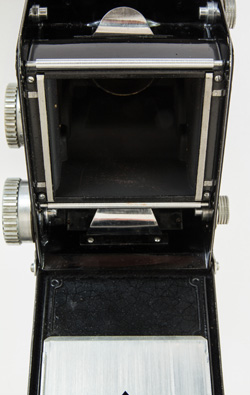
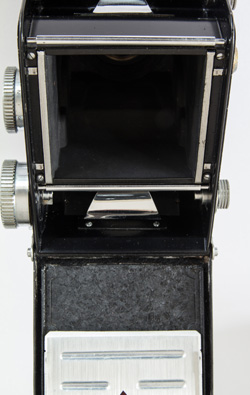
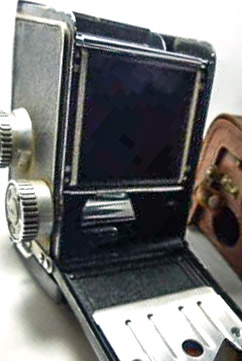
 (Pigeonflex IA detail from larger web image, IC detail from larger seller image)
(Pigeonflex IA detail from larger web image, IC detail from larger seller image)
See also comparison to similar Tokyo Optical Co. (Topcon) back further below.
Although the visual impact is somewhat retro, harking back to earlier Rolleicord design cues, the trim/design changes are either probably entirely related to the cost and sourcing of components, or the cameras were made by someone else. Almost certainly, there are no parts from the original Pigeonflex or its immediate Shinano made successor, the Pigeonflex IA.
Pigeonflex I Images
Typical Model I below:
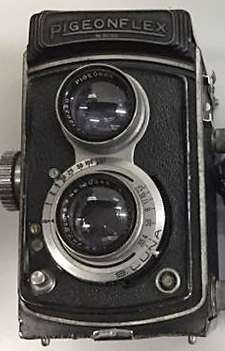
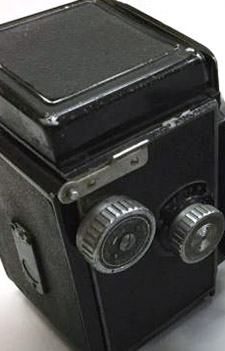 (Detail from larger web images)
(Detail from larger web images)
Cosmoflex trim examples are shown further below in Alfa Optical Co. - Pigeonflex Look-alikes, however, the following camera brings many of the similarities together in the one example; the straight “coat tails”, locking lever, winding and focusing knobs and trim and general appearance. The S. Luna and T.S.K. shutters are thought to be made by the same company, see discussions elsewhere on this page, both are common on Alfa Optical Co. models and the T.S.K. has been found fitted to three Pigeonflex I examples:
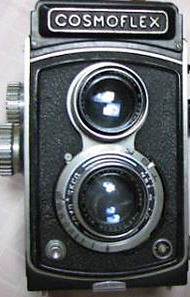
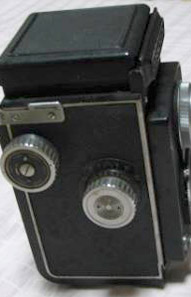 (Detail from larger web images)
(Detail from larger web images)
Pigeonflex I T.S.K. Shutter Type: Images 1 & 2 below are of the earliest example, image 3 is of a Cosmoflex II tripod mount/locking lever. The lens numbers are not the lowest of all model Is. by a small margin but I suspect this is from the beginning. Although different to other model Is, it is still typical Alfa Optical Co.-like in that there is no serial number on top of or on front of the nameplate and the tripod mount/locking lever is the same as found on some Cosmoflex examples.
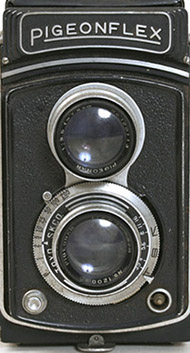
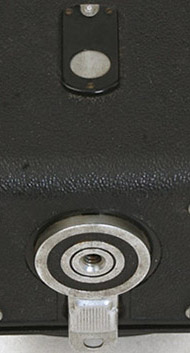
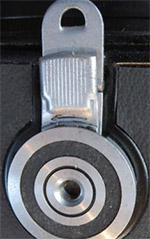
(Detail from larger web images)
A second one is very similar but has a serial number below the name on the nameplate (the lowest readable number in my database. The third one is different. It has the typical Pigeonflex I/IB/IC tripod mount/locking lever and adds the textured style nameplate from the model IC below. It is the only model I with this style of nameplate and also the only one with the serial number along the the top edge (on the others, it is below the name). The serial number looks like it might be 326xx but is quite doubtful. Other serial numbers range from 305xx to 309xx indicating not many made so 326xx maybe either optimistic, or indicating a numbering change, or it could be a replacement from a late IB or IC. The taking lens number is closer to the others but still higher and the viewing lens is second highest (there is an earlier camera with by the far highest viewing lens number of all). So there is little doubt that this is from the end of Pigeonflex I production:
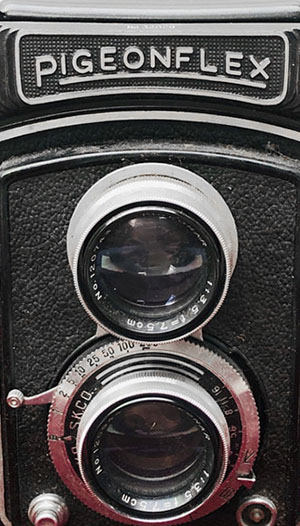 (Detail from larger web image)
(Detail from larger web image)
Pigeonflex IB Images
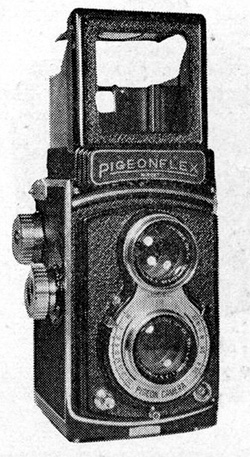
 (Right is detail from larger web image)
(Right is detail from larger web image)
(Left is detail from larger web image scanned by Rebollo_fr from January 1955 edition of Japanese magazine Shashin Kōgyō)
This is an early IB with the serial number below the name, like the above example in the scanned image and also the model I. Note, that the Tri-Lausar viewing lens is f/3.5, not f/3.2 as claimed by Camera-wiki.org:
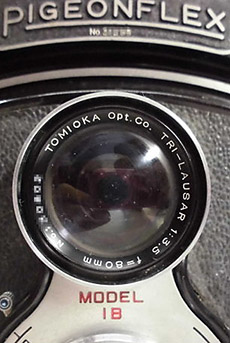
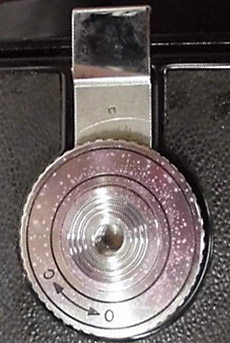
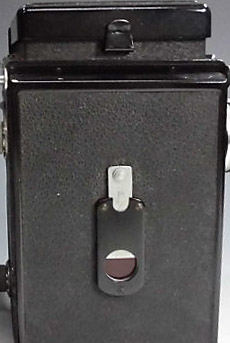
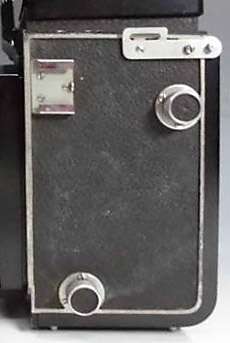
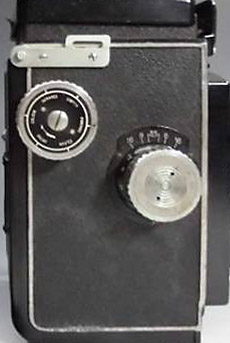
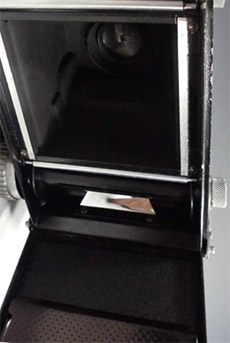
(Details from larger web images)
Below is the nameplate from a later example with the serial number on the top edge, as it is for the IC further down and for all later examples of the IB. In all cases, the numbers are 5 digit:
 (Detail from larger web image)
(Detail from larger web image)
The next example owned by contributor Sandu Baciu is both interesting and an enigma. It has the earliest clear IB serial number (30546) in the early position under the name but in all other respects, it seems to be last IB example in my database so it looks like the nameplate may have been changed. However, whilst that is certainly a real possibility, we are considering quite low production volumes over a relatively brief period and it is also possible some things got muddled. The main thing to remember is early nameplate, late camera.
In my mind, there are two things that make this a late IB example. The first is easy - it has the highest taking and viewing lens numbers of any IB, in fact by quite a margin (132480 and 132495). It also features the updated focusing hood found on what I believe is the IC further below:
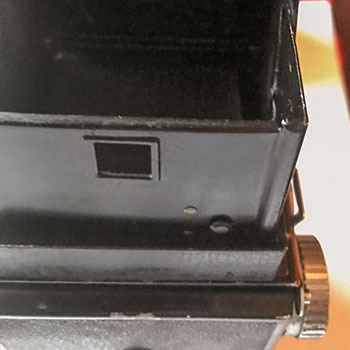 (Image courtesy of Sandu Baciu)
(Image courtesy of Sandu Baciu)
The detail of the pressing is a little different to the earlier type including the frame around the viewfinder hole. There is also a release button. Not visible in this image but I can confirm that the large square magnifier frame is identical to the IC and quite different to the earlier type with lifting tab. The catch on the hood frame to secure the hood in a closed position is no longer there. There are at two other IB examples in my database like it: camera with late serial number 3161x, taking lens 13175x and viewing lens 13176x and camera with unknown body serial number but taking lens 13176x and viewing lens 13178x.
Like all the other IB examples, its viewing lens is f/3.5. The rest of the visible features are typical of the IB:





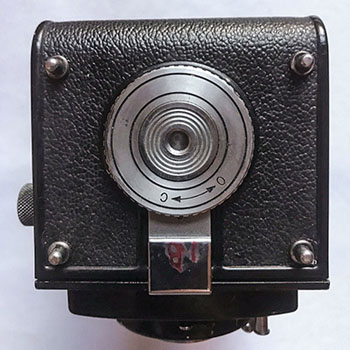
(Images courtesy of Sandu Baciu)
The camera with the later hood mentioned above, with taking lens 13176x and viewing lens 13178x, has a textured nameplate like the late Pigeonflex I with T.S.K. shutter pictured above and the IC below:
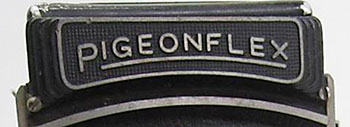 (Detail from larger web image)
(Detail from larger web image)
Pigeonflex IC Images
This camera has a textured nameplate:

It has the slightly different focussing hood with square magnifier and no rear catch of the previous late IB examples mentioned above. In all other respects, and except for the 7.5 cm Pigeonar lenses, it seems to be identical to a typical IB.
Unfortunately, the photos of the side detail have suffered badly from flare and/or focus issues but can be seen to be the same as the IB photos above:






(Detail from larger seller images, camera now owned by a correspondent)
A photo of the inside showing film guide and pressure plate detail is above in the Trim section and in the Tokyo Optical Co. (Topcon) section below.
Note that the ever ready case now has a separate top piece in common with Yashima Flex and later Yashima cases. The embossed logo is the same as on earlier Shinano examples but the embossed name now has a new italicised style without the border. The case appears to be the same as the late model I case and also looks very similar to cases found with Alfa Optical Co. cameras.
Pigeonflex ID
Daring to be Different
As mentioned earlier in “Mystery models”, I am relying on a Japanese spreadsheet for the name. This camera is a paradigm shifting model. Whilst it is still clearly a Rolleicord based copy, every detail is different to earlier models. It is harder arguing that the models I, IB and IC were made by someone else than Shinano because it has been commonly accepted that Shinano made everything except the original Pigeonflex. This camera confirms that Endō was not committed to any particular manufacturer and makes the earlier Alfa Optical Co. link more plausible. By looking through my database of TLR photos, it was easy to identify Tokiwa Seiki as the most likely maker.
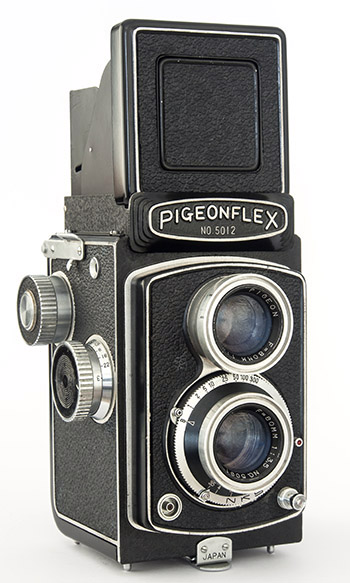
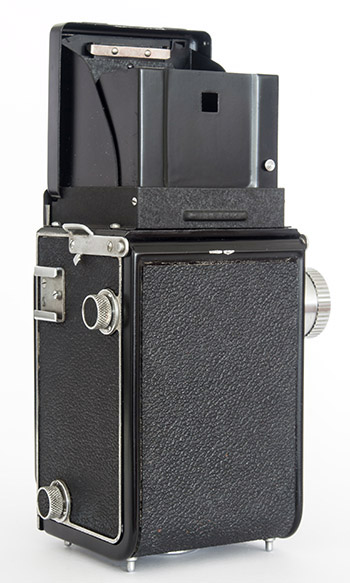
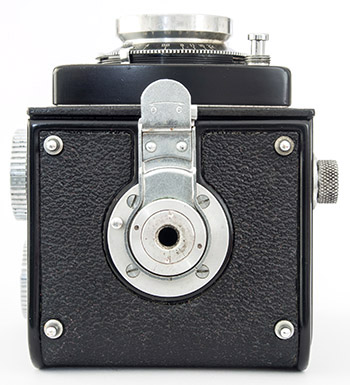
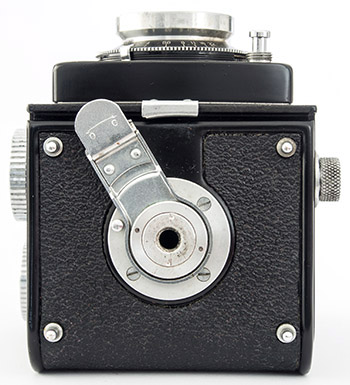
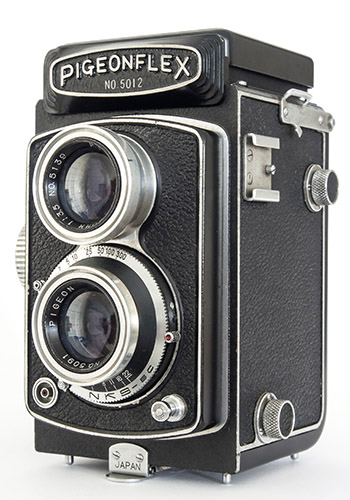
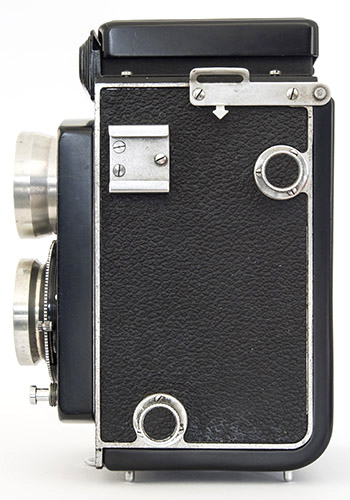
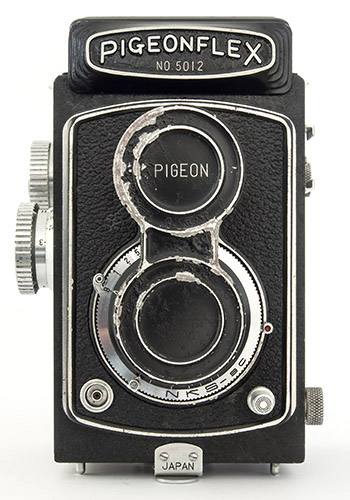
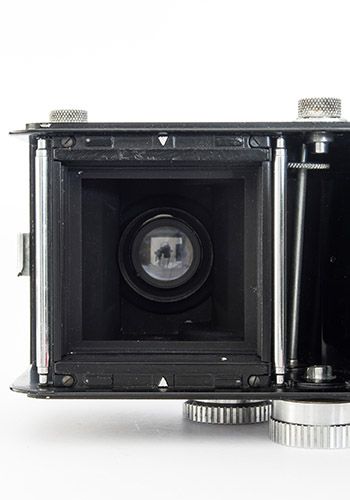
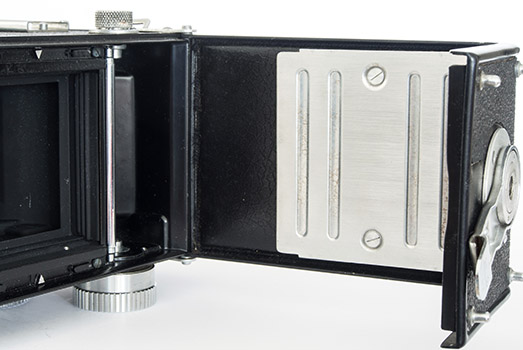
Although still with short strap holders, this is the first model with the “new” Rolleicord body style casting (as most Japanese makers eventually moved to, most noticeable from the front) and the first that alters the core Pigeonflex specifications. For the first time, film advance is auto-stop and film counter with manual counter reset instead of red window. Also new is the (basic) internal light baffle. The unmachined film guides look exceedingly rough in this photo, in reality, they are smoother than appears. Note the shutter button on camera left (right side of photo). The shutter is an NKS-SC, most often found with 1/200 top speed including on Tokiwa Seiki made models that use it, but on the Pigeonflex ID, the NKS-SC has a full range of shutter speeds of B and 1-1/300 plus self-timer. The lenses are “Pigeon” branded 80 mm with f/3.5 taking and viewing lenses. The reflections (both number and size) indicate that both lenses are triplets, unfortunately the taking lens does not appear to be a 4 element type as on the otherwise very similar Soligor models (see below). Their split-image prism rangefinder focusing is also missing but unlike previous Pigeonflexes, there is a Fresnel focusing screen. The name “Pigeon” on the lens cap is in the same style as on the IB above but there the similarity ends. The lens bezel size is 36 mm.
Unusually, both the camera serial number, 5012, and lens numbers (5091 taking and 5139 viewing) are four digit. Other models/brands that can be linked to Tokiwa Seiki, including Soligor TLRs, don't have obvious body serial numbers except for the Marioflex which is also four digit. However, all lenses except the unnamed f/3.2 viewing lens on Autoflex crank-wind examples, also have four digit serial numbers. It seems that production levels were expected to be low and/or at least never lifted to significant numbers.
Note, the hood blind has a superficial resemblance to Pigeonflex I and IB/IC models but close inspection confirms that they are different designs and the magnifiers share no similarities at all.
Related Tokiwa Seiki Models
The company and its products are described in more detail in Tokiwa Seiki, a Late Recruit further below. It was responsible for making TLRs under a number of different brand names, probably all, or most, for sale by other companies. The three most relevant to the ID, and perhaps the Automat below, are the Firstflex, Soligor and Autoflex models. The post-War Firstflex range was made for distributor Minagawa Shōten and is commonly known for budget pressed metal geared lens types (the only versions identified by Camera-wiki.org) but a search will bring up examples of Rolleicord look-alikes with both plain and Bay 1 mounts. Note however, the Bay 1 equipped knob-wind Firstflex model is almost certainly made for Minagawa by Lustre. These have the same tripod mount/locking lever, similar trim, and “Synchro-Super” shutter as some Lustreflex models and have “L.K.K.” engraved in the accessory shoe. Tokiwa Seiki made examples of the Skymatic and Oplenflex crank-wind models (both based on the Autoflex) have a stylised logo in the shoe which probably says “TSK”:
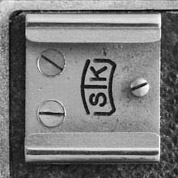 (Detail from larger web image)
(Detail from larger web image)
Some claim it is “SK” or “STK” but only “TSK” makes sense even though it is not clear what the “K” stands for. Camera-wiki.org refers to “Tokiwa Seiki K.K.” In Japanese, “K.K.” is the equivalent of “Co., Ltd.” I don't see a lot of evidence that the business was actually called “Tokiwa Seiki K.K.”, besides that would logically make the abbreviation “TS” or “TSKK” but nevertheless, it may be the case. Another possibility is that it is “Kōgaku”, meaning optical, which often appears in camera makers names - no actual evidence for that. There may also be an alternate explanation. Barry Toogood has an Autoflex box on his site www.TLR-Cameras.com marked “Tokiwa Seiki Works”. I'm not familiar with Japanese but “Kōgyō” is often translated as “Industries” (as officially translated in Yashima documents) but I understand that it can also mean “work”, so maybe it is also associated with “Works” - don't quote me on that!
Two trim items common to most Tokiwa Seiki made die cast Rolleicord copy TLRs (including the Pigeonflex ID) are the focusing hoods (see various examples in this section) and the back locking levers/tripod mounts:
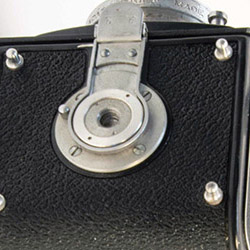
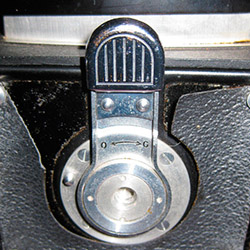 (Detail from larger web images)
(Detail from larger web images)
The first example belongs to a Soligor Reflex II, the second to a crank wind Autoflex (the rubber or plastic tip on the otherwise identical mechanism is present on some Autoflex examples but not others). Another common similarity (except for Bay 1 fitted models) is the style of the plain 36 mm filter mounts as seen on the Pigeonflex ID above and other examples below. Left handed shutter buttons are found on models which most closely match the Pigeonflex ID and die cast Soligor pair for features.
Three models were made for the US importer and distributer Allied Impex Corporation (“A.I.C” in a diamond shaped hood logo) brand Soligor; “Reflex” (geared lens, pressed metal), “Reflex II” (red window film advance) and “Semi-Auto” (auto-stop winding). From period ads and articles, they appear to have been released concurrently. The link between these cameras and Tokiwa Seiki is also noted by Japanese site tlr66.com and apart from the Pigeonflex ID, a 2008 discussion by contributors to Camerapedia seems to be in alignment with the conclusions that I have independently reached (in 2016) about which key models Tokiwa Seiki was responsible for. In Tokiwa Seiki, a Late Recruit, I note that the “Soligor 35” camera marketed by A.I.C. is a version of Tokiwa Seiki's “Firstflex 35” SLR. This is a claim made by Camera-wiki.org and others but is also abundantly clear from photos of the two models.
All three Soligor models are typically found with a silver nameplate (see further below) but the Soligor Semi-Auto and Reflex have also been found with a stepped nameplate, I assume a later variation. Otherwise, the cameras appear to be identical to the silver nameplate type:
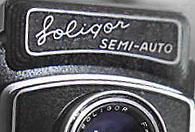 (Detail from larger web image)
(Detail from larger web image)
Except for lenses, shutter, focusing aid and the nameplate, the Soligor Semi-Auto is an exact twin of the Pigeonflex ID (as is the Reflex II, except for film advance). That seems like a lot of exceptions but still leaves the complete body, inside and out, back locking mechanism, focusing hood, all knobs and controls, lens bezels and left handed shutter button. According to the December 1955 edition of Modern Photography, the Reflex had a 3 element lens, the other two, 4 element lenses and split-image prism rangefinder focusing. Lenses are named “Soligor Anastigmat” on the Reflex and “Soligor” on the other two. All have “Rektor” shutters with a full range of speeds to 1/300. A 1957 US Popular Photography magazine “Twin-Lens Roundup” comparison of under $100 TLRs noted that the price of Semi-Auto was $59.95 compared to $46.50 for the Yashica C, $59.95 for the Yashica LM and $75.50 for the Yashica-Mat. The Yashica C had the advantage of Bay 1 mounts but the Semi-Auto had the 4 element lens and more sophisticated split-image prism rangefinder focusing.
The Autoflex range is crank wind, either with or without Bay 1 mounts (both with typical Tokiwa Seiki trim details).
I have found one almost exact Firstflex clone of the Soligor Reflex II and close relative, Pigeonflex ID (except for film advance) but unfortunately the resolution is very low, left image, and a very similar Autoflex interior to the ID above (except for the lever for automatic reset of the frame counter), right image:
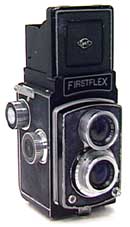
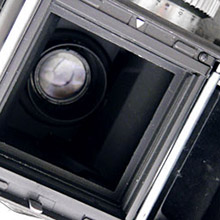
(Web image left, right is detail from larger web image)
In the left image, note the silver trim behind the focusing and winding knobs, the similar locking lever, plain filter mount style, appearance of the hood with the silver trim line pushed closer to the hood edge than most other maker's cameras, arrow shaped strap hook on the strap holders and the shutter button on camera left. The interior in the right image has the same overall style, black film guides and “landing pads” for the pressure plate, silver start-mark arrow and light baffle.
The first photo below left is of a Soligor Semi-Auto (Pigeonflex ID twin) from Barry Toogood's TLR-Cameras.com site (now defunct). The second photo is Barry Toogood's different Firstflex knob-wind model with focusing knob and shutter button on opposite sides (regardless of that, or silver or black trim, note similar distinctive style focusing hood, filter mounts and locking lever). The third photo is a crank-wind Autoflex with typical plain mounts and locking lever (the sports finder has modified trim but the outer part is the same). The fourth photo is a crank-wind Autoflex with Bay 1 mounts featuring a rim set shutter, i.e., without faceplate over the shutter assembly. The fifth photo is a crank-wind Autoflex with Bay 1 mounts and faceplate and typical Tokiwa Seiki focusing hood and locking lever:

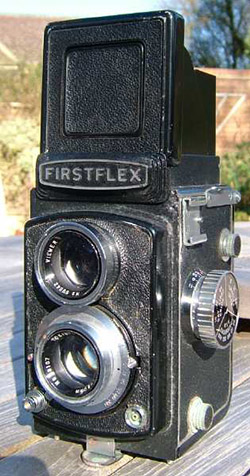
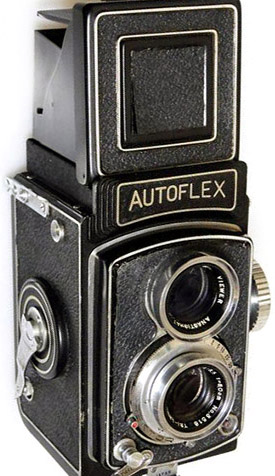
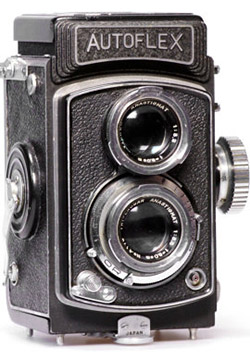
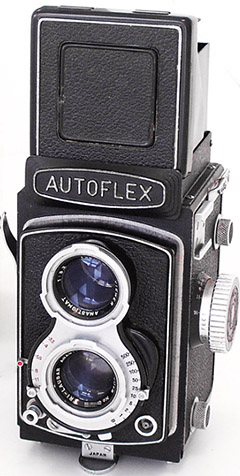
(Images 1 & 2 are courtesy of Barry Toogood, 3, 4 & 5 are details from larger web images)
Two other almost certainly Tokiwa Seiki made crank-wind cameras, the Skymatic and Oplenflex, are clearly derivatives of the Autoflex, probably made for different marketing companies. The examples found look like the middle type.
Note, most, but obviously not all, knob-wind Firstflex versions found with plain mounts have the focusing knob on the opposite side to film winding knob but the same type of locking lever and hood as the others (as shown above). Knob-wind versions with Bay 1 mounts have the film winding and focusing knobs on the same side but the hoods and locking levers are different to other versions (probably made by Lustre). Note also the use of nameplates with different style oval surrounds somewhat reminiscent of Yashima models (I suspect copying of a now successful company rather than any link). The Firstflex style is somewhat similar to the contemporary Yashica A nameplate and the Autoflex is similar to the Yashicaflex model C/ Yashica C, as is the Pigeonflex ID whilst still retaining the curved name.
Pigeonflex Automat
Phantom Model
I am confident of presenting this as an actual model even though I am not aware of any example having being found. Like with the ID, its existence was pre-empted by the Japanese spreadsheet linked in the “Mystery Models” above. However, its appearance in an ad in a Japanese magazine style daily, “Mainichi Graphic”, dated 30 September 1956, pretty much confirms it for me (note, I have not sighted the actual ad, only a description of the ad in the sale listing):
(Click on cover for Google translated description of contents)
Whether it was ever sold is a different question. Apart from adding crank-wind, its features and specs are unknown. I am only guessing that it was a Tokiwa Seiki made companion model to the ID but there is no evidence for that apart from being from a similar period and the fact that Tokiwa Seiki had models available. Pigeonflex models were basic cameras, or rather, had been up to this point, so crank-wind seems rather luxurious, however, as noted in Tokiwa Seiki, a Late Recruit, crank-wind models were available with Tri-Lausar triplet lenses and as we have already seen, rim-set shutters and plain filter mounts as well as with more typical higher-end features. The Pigeonflex ID had already taken the brand a little further up-market.
Serial Numbers
Below are body and taking lens serial numbers found for Pigeonflex models other than Yashima made examples which can be found here (all 6 digit numbers). The Shinano made IA has body and lens serial numbers belonging to different ranges than later models which seem to share their own ranges. The fact that IA body serial numbers are higher than for later models shouldn't be considered overly significant, the first Yashima Pigeonflex examples also had higher serial numbers than the bulk of later cameras. However, the higher IA body serial numbers and four digit lens numbers do contrast it to the more homogeneous grouping of I, IB and IC models. It doesn't provide any evidence that the IA has a different DNA, but importantly, it is not inconsistent with that idea. The ID has a 4 digit serial number, again suggesting that it is different to the others. I have used highlighting to group the models by their three distinctly different styles/components and hence, probable makers:
Pigeonflex
Model |
Body Serial No. Range |
Lens Serial No. Range |
No. Found |
Probable Maker |
||
From |
To |
From |
To |
|||
IA |
500xx |
516xx |
54xx |
67xx |
17 |
Shinano |
514xx |
515xx |
168xx |
169xx |
2 |
||
517xx |
518xx |
401xxx |
403xxx |
3 |
||
I |
305xx |
309xx |
1200xx |
1209xx |
10 |
Alfa Optical Co. |
IB |
305xx |
316xx |
1304xx |
1324xx |
12 |
|
IC |
1500xx |
1 |
||||
ID |
5012 |
5091 |
1 |
Tokiwa Seiki |
||
“No. Found” represents number of examples found with body and/or lens serial numbers visible. The frequency of the later models turning up is quite low compared to Yashima made examples. The spread of serial numbers, whilst an extremely limited sample, is suggesting low production volumes, perhaps under 3,000 in total compared to 7,211 for Yashima examples according to Karl F. Kahlau and perhaps significantly more according to serial numbers.
Note: As noted further above, the very earliest IAs have the serial number on the nameplate top edge. It then moved under the name on the nameplate where it remained for the few model Is found so far and also on the earliest of the IBs before reverting to the top again. On the ID, it is on the front once more.
Outsourcing of Components & Maybe More
(This section considers the common design and components of the Pigeonflex I and IB/IC and how and why they are repeated in some other companys' models.)
The background to Japanese TLR design and production was outlined in The Yashica & TLR Stories and Design Heritage. The consensus seems to be that smaller businesses bought in parts and even assemblies. This avoided costly design issues and the expensive start up capitalisation costs of tooling and plant and it is the only way that small businesses could have started and continued to exist, unless they achieved significant growth, as Yashima did.
Camera-wiki.org mentions claims that the dies for the pre-War and War-time Rollekonter, a faithful Rolleicord copy, survived the War and may have been used by a sub-contractor supplying body castings to a number of camera makers. There is also a discussion on a Japanese website, featuring the very early Yashimaflex nameplate mentioned elsewhere, which talks about the common use of die casting foundries at the time. However, regardless of that, there are also castings which look very similar to each other, and to the Rolleicord, but with tell-tale differences indicating different dies were in use - it is easy to jump to too many conclusions.
As already noted, one company's cameras do bear a remarkable resemblance to the Pigeonflex I and IB/IC but there are certainly other small manufacturers who also used similar components.
Alfa Optical Co. - Pigeonflex Look-alikes
The Company and its Cameras
The Alfa Optical Co. produced two ranges, the Alfaflex and the Cosmoflex (models I, II and III). They were advertised from February 1953 to December 1954. The Alfaflex is the rarest and is quite basic without sports finder and accessory shoe. Early Alfaflex:
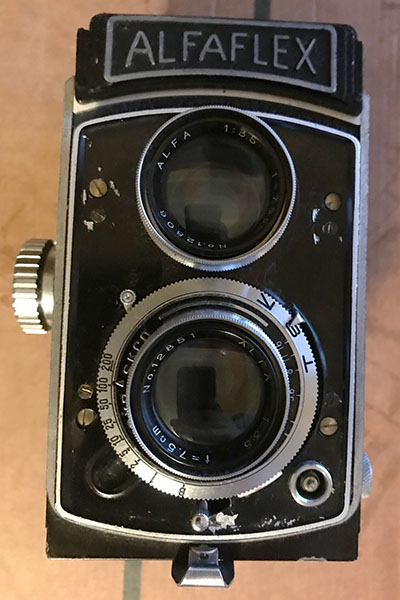 (Image courtesy of Sandu Baciu)
(Image courtesy of Sandu Baciu)
It is the least like the Pigeonflex I and IB/IC cameras but nevertheless, some features are the same as will be pointed out further below:
The Cosmoflex I has a sports finder and may or may not have an accessory shoe, its trim and specs varying with age. The Cosmoflex II is a more basic variant without sports finder and and accessory shoe and seems to be a direct replacement for the Alfaflex. The Cosmoflex III is similar to the I but with auto stop and film counter replacing the red window. The majority of earlier examples are fitted with T.S.K. shutters and later examples with similar spec S. Luna shutters (as also used on the Pigeonflex I). The T.S.K. shutters also have a marking “TOYO S.K. CO” and the Cosmoflex II user manual refers to “T.S.K. Luna” shutter implying that they may be from the same company.
The abbreviation may stand for Tōyō Seiki Kōgaku which Camera-wiki.org claims is the maker of the Princeflex TLR (advertised from 1953 to April 1955) and Elbowflex TLR and Elbow 6 folder (advertised by the company in April 1955). In September 1955, the Cosmo 35 (see Pigeon 35 Based Cameras) was announced and advertised by Cosmo Camera Seisakusho along with the two earlier Elbow cameras previously advertised by Tōyō Seiki Kōgaku. Camera-wiki.org suggests that Cosmo Camera Seisakusho was the successor company to Tōyō Seiki Kōgaku and that given the “Cosmo” name link (Cosmoflex range), Alfa Optical Co. may have been absorbed into Tōyō Seiki Kōgaku/ Cosmo Camera Seisakusho. The “S. Cosmo” lens name found on all Alfa Optical Co. TLRs is used on the Cosmo 35 camera and that is a very significant link. Camera-wiki.org further speculates that Chihaya, CHY-SB and CHY-FB shutters are related and that the CHY-SB is a very close successor to the S. Luna.
Most Alfaflex and Cosmoflex cameras in my database are fitted with S. Cosmo lenses with serial numbers in the teens and the bodies have the ASA type flash sync. A later Cosmoflex I with lens numbers 31xxx and PC flash sync is fitted with a “Cosmo” shutter.
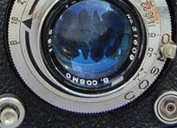 (Detail from larger web image)
(Detail from larger web image)
Two slightly later again Cosmoflex III examples with lens numbers in the 32xxx range (both with PC flash sync) are fitted with CHY-SB shutters (Camera-wiki.org also notes an example). Whilst not confirmed, it would be reasonable to speculate that T.S.K. shutters became S. Luna, became Cosmo (briefly), became CHY-SB.
Not really relevant but I have photos of two Cosmoflex cameras, both probably II types, with shutters marked “Lunar” instead of “S. Luna”. Camera-wiki.org notes that in an advertisement by distributor Matsuzaki Shashinki-ten dated May 1953, the Cosmoflex shutter name is spelt “Lunar” and that this must certainly be a mistake. Obviously not! S. Luna on left and Lunar on right (I assume that “Lunar” is earlier, the lens has a much lower serial number):
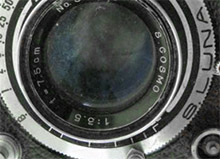
 (Detail from larger web images)
(Detail from larger web images)
Pigeonflex-like Features
This Alfa Optical Co. Alfaflex hood and magnifier are identical to the Shinano Pigeonflex I (there are other types as well). Whereas the I and IB/IC Pigeonflexes lost the hood logo introduced on the IA, I haven't found any Alfa Optical Co. hoods with one. So, not only are some hood assemblies of the same type, there seems to be a common aversion to the use of hood logos.
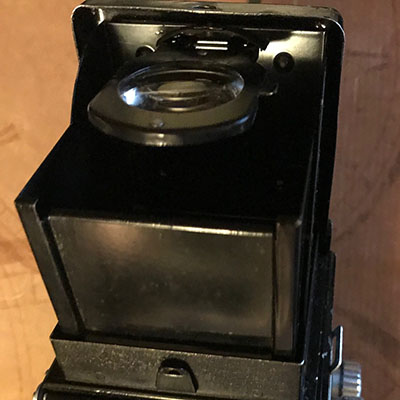
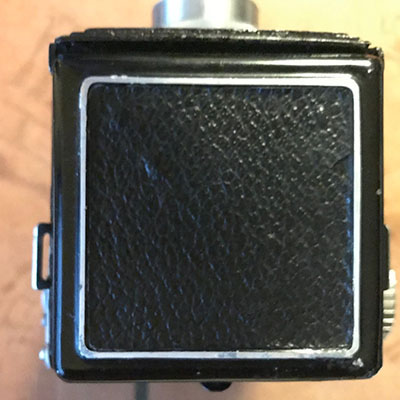
(Images courtesy of Sandu Baciu)
The red window is also identical to the Pigeonflex I and IB/IC but that style appears on many Japanese TLRs (almost exact copy of pre-War Rolleicord type). Whilst the film winding knob of the Alfaflex is different, the focusing knob is similar:
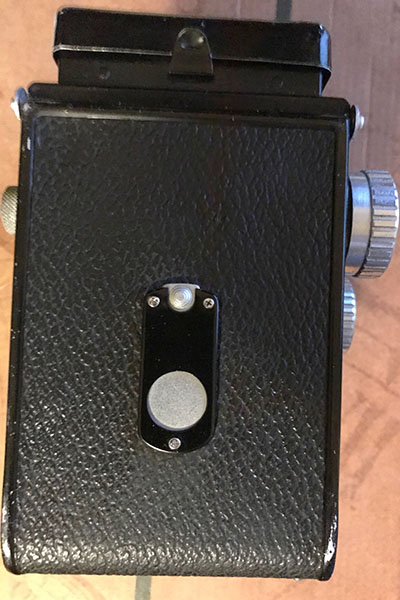
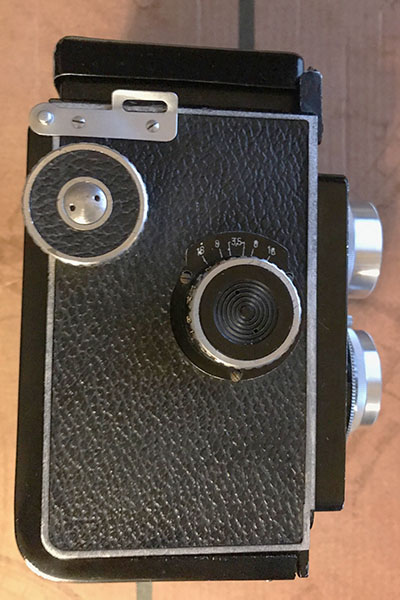
(Images courtesy of Sandu Baciu)
However, on some Cosmoflex versions, the film winding knob, the focusing knob and back-plate detail appear to be an exact match to the later Pigeonflex models. Three different Cosmoflex cameras with the same knobs, middle with silver end cap, like on Pigeonflex I and IB/IC examples, instead of black which otherwise appears the same:
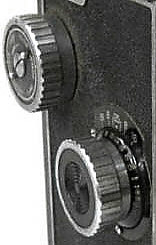
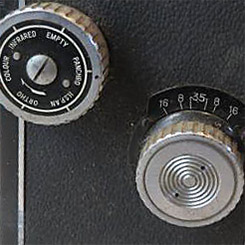
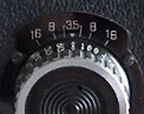 (Detail from larger web images)
(Detail from larger web images)
The lens bezel design with inner and outer mounts appears to match the Pigeonflex I and IB/IC and the knurling on this example matches the plain model I above. Although the “coat tails” on many examples spread out a little further at the bottom, the side profile and fitment is the same and the example shown under Pigeonflex I Images, further above, is identical in all respects including the “coat tails”:
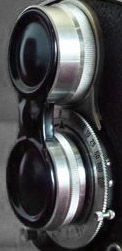 (Detail from larger web images)
(Detail from larger web images)
The font and general style, layout and order of text on the lens retaining rings of lenses featuring simply “S. Cosmo”, rather than the earlier type which adds “ALFA Opt. Co.”, appears to be near identical to the style of Pigeonflex I and IC (IC from above shown, note slightly different bezel design related to faceplate shutter cover). Even the retaining rings of the plain “Alfa” lenses of the featured Alfaflex above are similar. The cameras also share the “7.5 cm” focal length as opposed to the 80 mm of the Tri-Lausars and earlier Pigeonars:
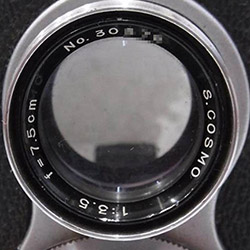
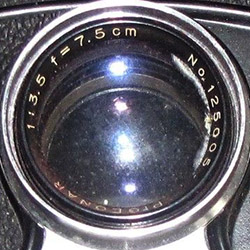 (Detail from larger web images)
(Detail from larger web images)
Alfa Optical Co. models have at least three different types of locking lever including a basic type with curly front (combination of very early Rolleiflex and Rolleicord design), but at least one type (found on all, or nearly all, Cosmoflex I and III models) is an exact match for the shape of the front part of the lever that is visible on the model I (two exceptions), IB (one exception) and IC examples above and with the tripod mount/locking knob shown in other photos for the three models (apart from the three exceptions), i.e., the complete assemblies appear to be identical - that is very significant, I haven't seen this type on any other cameras (note also the very similar ASA flash sync socket design, regardless that they are both ASA types):
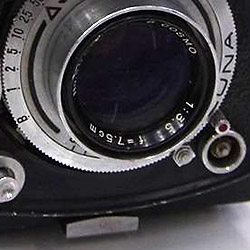
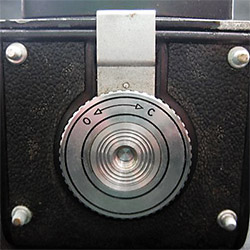 (Detail from larger web images)
(Detail from larger web images)
There are two Pigeonflex I examples which have a different tripod mount/locking lever but there is an exact Cosmoflex II match - see Pigeonflex I Images above. Also, the earliest Pigeonflex IB in my database has a basic type tripod mount with lever with curly front to it as also found on older Alfa Optical Co. cameras like the Alfaflex at the top of this section.
Except for the absence of an accessory shoe, the photo of the Alfaflex spool knob side detail below left appears to be an exact match to the Cosmoflex III in the middle and the Pigeonflex I and IB/IC on the right (Pigeonflex IB from above shown on the right). The accessory shoes of the Cosmoflex III and Pigeonflex IB appear to be the same unusually short style and shape and are identically located. The film spool backing plates of all three have the three screws in exactly the same orientation as the models I and IB/IC top and bottom and the strap holder plates appear to be the same design and kick up at the hinge position whilst on the Yashima Pigeonflex and the Pigeonflex IA, they droop down. Although not clear from these photos, the knurling on the spool knobs also appears to be identical:
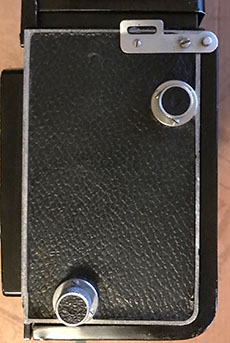


(Image 1 courtesy of Sandu Baciu, images 2 & 3 are detail from larger web images)
The internal body casting of the Cosmoflex II below (no Yashima or Shinano IA pressure plate “landing pads”) and the black Cosmoflex I pressure plate (similar to most visible Cosmoflex II and III pressure plates) look the same as the Pigeonflex IB above and IC and Tokyo Optical Co. (Topcon) examples below.
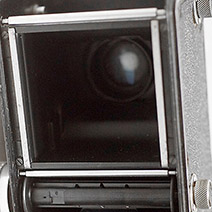
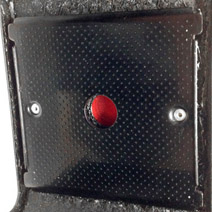 (Detail from larger web images)
(Detail from larger web images)
One visual differentiator is that the Pigeonflex bodies have a curved aluminium ridge piece between the nameplate and the focusing lens board. It is there on the Alfaflex and on the Cosmoflex II, but on the Cosmoflex I and III, it has a black cover plate so it is not obvious (as with Yashima cameras, there are also early and late body types but here I am only comparing to the early type relevant to Pigeonflexes I and IB/IC). Relying on photos alone, certain Alfa Optical cameras and Pigeonflex I and IB/IC models look like they have come off the same production line.
Similar Components - Other Relationships
Tokyo Optical Co. (Topcon)
Tōkyō Kōgaku, or Tokyo Optical Co., later better known as Topcon (Camera-wiki.org) used several brand names including Primoflex and Laurelflex. I'm not suggesting that there was any direct connection with Pigeonflexes, or indeed the Alfa Optical Co. There does not appear to be any use of lenses or shutters from the same suppliers. Although it is hard to know about body castings, generally the Tokyo Optical Co. bodies are probably the least obviously similar to the others, but there is one type with some common features. Pigeonflex IC interior on left, Primoflex on right, model unknown but has plain filter mounts and a film counter. Its back has a locking mechanism not found on Pigeonflex models but appears to be identical to the “curly” type found on some Alfa Optical Co. and Alpenflex models. The two images below illustrate a very similar body casting. The film guides are typical but most TLRs have four machined “landing pads” outboard of the guides for the tabs on the pressure plate (some are square, others rectangular and some have rounded ends). Two similar raised areas near the bottom of the guides are visible in the two photos but these are clearly different in shape to the machined pads of Yashima cameras and the Pigeonflex IA. The other similarities are the black pressure plate in each camera when plain aluminium was perhaps more common and similar mounting arrangements for the bottom film spool pressure springs (at top of photos).

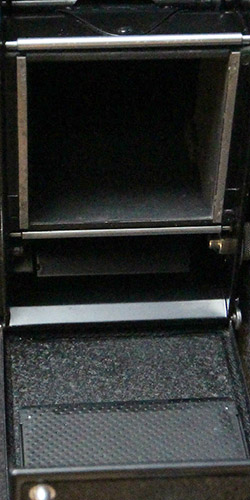
(Left image, detail from seller's photo of Pigeonflex IC, right is detail from larger web image)
The focusing hoods and red window assemblies on several models display a remarkable resemblance to both Pigeonflex I and IB/IC and Alfa Optical Co. models.
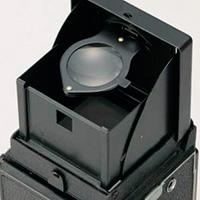
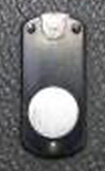 (Detail from larger web images)
(Detail from larger web images)
This Primoflex focusing hood magnifier is a different shape to the Pigeonflex I and IB/IC types but both have the two rivets, the tab on the side and what appears to be an identical spring arrangement for the magnifier. There seem to be several Primoflex magnifier shapes for the same style hood, with or without sports finder. Incidentally, this magnifier shape appears to be a straight copy of the Zeiss Ikoflex IIa type. Note that I have only found this type of focusing hood on models with plain filter mounts. Hoods on models with Bay 1 mounts, control wheels and crank wind appear to be different.
The Laurelflex magnifiers are not visible in the photos I have but the hoods seem to be the same as for some Primoflex models. The only Laurelflex examples I have photos of are of models with auto-stop film winding with film counter. These have the red window assemblies on the base, like early Rolleicords, for setting the film start position. Some early Primoflexes also use the windows on the base but basic model/s relying on the red window for frame counting, have them in the usual position on the camera back. All the red windows appear to be of the same type.
Interestingly, the Primoflex viewing lens bezel with the inside and outside push-on mount appears to be the same as the Alfa Optical Co. and Pigeonflex I and IB/IC examples and the knurling appears to match both the Alfa Optical Co. and Pigeonflex I examples. The Primoflex “coat tails” appear identical to those of the Pigeonflex I and very similar at least to most Alfa Optical Co. models but with at least one Cosmoflex example also identical (see further above):
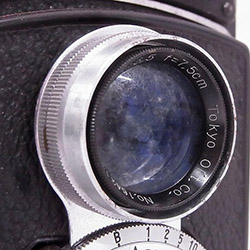 (Detail from larger web image)
(Detail from larger web image)
Lustre Flex
One model of the Lustre Flex (as written on its box but also known as the Lustreflex) has a film winding knob with film type reminder matching both the Pigeonflex I and IB/IC and Alfa Optical Co. models:
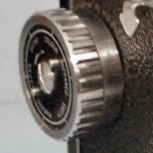 (Detail from larger web image)
(Detail from larger web image)
There are a number of lens bezel variations with some of the “coat tail” variations familiar. However, there is one type with inner and outer mounts and knurling which appears the same as the Pigeonflex I and Alfa Optical Co. and Tokyo Optical Co. examples and with the “coat tails” appearing to be an exact match to the Alfa Optical Co. example above.
There appear to be no other exact similarities to the Pigeonflex or Alfa Optical Co. models. Some late Firstflex examples share some apparent similarities with Lustre Flex models but those similarities are not shared with the Alfa Optical Co. models or Pigeonflexes. It was all a little incestuous really.
Link Between Alfa Optical Co. and Lustre Flex?
Camera-wiki.org suggests that CHY-SB and CHY-FB shutters are related to the T.S.K./S. Luna used by Alfa Optical Co. and made by its partner/successor company. Whilst Lustre used various shutters, I have photos of two with CHY-FB. That works in reverse too. Here is a Cosmoflex II with Lustre shutter:
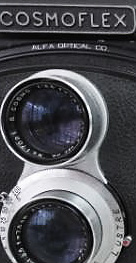 (Detail from larger web image)
(Detail from larger web image)
Although Lustre was a separate company, it seems to be responsible for at least one version of the Elegaflex. Camera-wiki.org also speculates about a link between the Elegaflex and Elbowflex made by camera and T.S.K. shutter maker Tōyō Seiki Kōgaku.
Alpenflex
Some cameras have the Rollei type red window appearing with various models above and at least one example has a matching hood and magnifier to the Tokyo Optical Co. (Topcon) example above. I have found no lens bezels which are the same as the Pigeonflex I type but several examples do have bezels with inner push-on mounts.
Malcaflex
Malcaflex TLRs were made by Musashi Optical Co. Ltd., Tokyo. The focusing hoods are similar to/same as the Pigeonflex I and IB/IC types, the red windows are the same except silver instead of painted black, the focusing and film winding knobs share elements that are similar to at least some of the cameras from the group of makers discussed so far. The Shutters used are T.S.K. which are believed to be the same as the S. Luna used by Alfa Optical Co. and the Pigeonflex I.
Tokiwa Seiki, a Late Pigeonflex Recruit
Tokiwa Seiki is best known for its Firstflex range of pressed metal geared lens TLRs produced between 1951 and 1955 but as noted in Related Tokiwa Seiki Models, it also produced a range of die cast models with front panel focusing, one of which is almost certainly the Pigeonflex ID, and perhaps also the crank-wind Pigeonflex Automat.
The company was also responsible for the post-War First 6 range of 6x6 folders. These are different to the earlier First cameras made by Kuribayashi, later known as Petri, for which a company called Tokiwa Kōgaku supplied lenses and shutters. Whether there is a link between Tokiwa Seiki and Tokiwa Kōgaku is unknown. There are also some unresolved claims that there is a connection between pre and post-War First TLRs but the evidence is mainly circumstantial. “First” is a name use by photographic distributor Minagawa Shōten which commissioned product much the same as Endō Sashin Yōhin. According to Camera-wiki.org, Minagawa went bankrupt in 1955. As Tokiwa continued to use the “Firstflex” name after the mid-1950s, perhaps it obtained the rights to it?
A number of ads from 1953 and 1954 advertise the First 6 V folding camera and two ranges of pressed metal geared lens TLRs. At least a couple of the ads mention Minagawa. The cheaper TLR range, from 6,800 to 8,500 yen, includes models P I, P II and PIII which feature a plain leatherette front panel (some versions have a striped silver decorative panel, mainly around the viewing lens) and plain focusing hood without sports finder. Examples of this range are rarely seen and infrequently mentioned. It may have first appeared as an economy range at the end of 1953. The second range, priced from 9,500 to 13,500 yen, includes models I, II, III, IIA and IIIA which feature a distinctly angular, sculpted, mostly silver front panel, push button shutter and an albada finder in the hood (at least in the top model/s). One of the features separating the many models in both ranges is shutter speed ranges, from a low of 1/25 to 1/100 to a high of 1 to 1/400, and just about every combination in between. By mid-1954, the P range, still P I to P III, seems to have adopted the body of the premium range which may have been rationalised to just models II A and III A. To put the price range of 6,800 to 13,500 yen for these budget cameras into perspective, the Rolleicord style Yashicaflex A-II was released at 9,500 yen and in 1955, the Yashicaflex C arrived at 11,500 yen. Yashima was turning the screws.
Around 1954 or 1955, the company produced an unusual 35 mm SLR with waist level finder, leaf shutter and interchangeable lens. This was called the Firstflex 35 and was also sold as the Lafayette 35, Windsorflex 35 and Soligor 35. A development of this, the 1955 Pentaflex, with eye-level porroprism viewfinder, beat the Miranda T with eye-level pentaprism viewfinder to market by four months. The Miranda T is credited as the first Japanese SLR with pentaprism eye-level viewing and the Pentaflex is largely forgotten, even though porroprism finders were later used on the Olympus Pen F half-frame SLR and budget SLRs/DSLRs. A second type Firstflex 35 was released in 1958. Earlier in 1958, Zunow introduced the first 35 mm SLR to combine automatic stop-down with instant return mirror. The second Firstflex 35 was the second camera with these features. Very modern and streamlined in appearance, it used the mirror as the shutter but it had one fatal flaw - there was only a single 1/125 speed. A later version called the Plusflex 35 in the UK had additional speeds (B and 1/60) and, it is claimed, was sold until the mid-1960s. Another version, called the “GM 35 SLR” was sold in the US (it may have only been single speed).
In about 1960, Tokiwa Seiki also produced a cheap 127 format 4x4 viewfinder camera called the Mykey-4. Camera-wiki.org hasn't confirmed the parentage of this camera but the Tokinon lenses and “TSK” logo also seen in some TLR accessory shoes ( see Related Tokiwa Seiki Models) make it fairly certain.
TLR brands not mentioned in Related Tokiwa Seiki Models include Bioflex and Kenflex geared lens pressed metal types. There are also die cast Marioflex and related Osiroflex TLRs credited by McKeown and Sugiyama to the same company alternatively known as OMS Optical and Osiro Optical (Camera-wiki.org). There are photos of both types at Barry Toogood's www.TLR-Cameras.com site, but I have also collected photos of several Marioflex and Osiroflex examples (some with slight variations), including with the back open. Both models use a manual film advance with red window. All examples have features typical of Tokiwa Seiki made cameras but the Osiroflex examples and one Marioflex are almost complete matches trim wise. I assume that the attribution by McKeown and Sugiyama should actually be for the marketing company. Lenses seem to be branded “Rozeck” with “Osiro Kogaku” appearing on some taking lenses. Shutters varied from NKS-SC (as used on the Pigeonflex ID), “Ceres” and Camera-wiki.org notes one example fitted with “Rektor” as found on some other Tokiwa Seiki made cameras. I'm not the only one that has noted the Tokiwa Seiki connection with either these models or others mentioned earlier - there are notes in Camerapedia of discussions in 2008 between Adrien Rebollo and others regarding this (Adrien Rebollo has been a key contributer to Camerapedia and what is now Camera-wiki.org).
There is one additional twist; one Marioflex and at least two Osiroflex examples have the typical Tokiwa Seiki hoods and other features but also have the diamond shaped hood logo with the letters “A.I.C” as found on US importer, Allied Impex Corporation, Soligor models made by Tokiwa Seiki (see Related Tokiwa Seiki Models above). The connection there is not known and can only be guessed at. The Marioflex is in nice shape complete with case, lens cap, box and instruction manual. The instruction manual is in Japanese so the Marioflex is unlikely to have been an export camera:
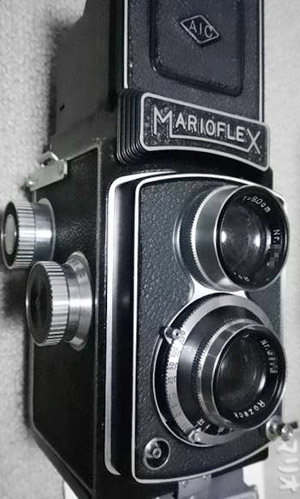 (Detail from larger web image)
(Detail from larger web image)
I can confirm from other photos that the locking lever/tripod mount and accessory shoe are typical Tokiwa Seiki types, the only obvious variations from standard are the plainer, more basic lens bezels (typical of Marioflex but not Osiroflex examples) and the missing arrow heads on the strap holders (found on some Marioflex examples but not others).
Crystar Kōki K.K., which later became K.K. Crystal, was a company credited with producing mainly geared lens pressed metal type TLRs with either “Crystar Flex” or “Crystar” on the nameplates. It also sold die cast, front panel focusing models. I have two named “Crystar” in my database. One has a more “normal” style focusing hood, the other, very similar to Tokiwa Seiki types and again like the Marioflex and Osiroflex, it has the “A.I.C” diamond logo. Both have their shutter release buttons on camera left and at least one has “Rozeck” lenses as found on Marioflex and Osiroflex models. Whether these are wholly made by Tokiwa Seiki is not possible to know at this stage but it seems certain that it is responsible for at least some of the parts.
For Tokiwa Seiki's other cameras, lenses found on geared lens pressed metal TLRs are usually branded “First Anastigmat”, on knob-wind models with plain filter mounts they are usually branded “Tokinon”, and on crank-wind Autoflex and Skymatic models they are usually “Tri-Lausar Anastigmat” but with an f/3.2 unbranded “Anastigmat Viewer” regardless of whether plain or Bay 1 filter mounts. The crank-wind Oplenflex matches the f/3.2 unbranded “Anastigmat Viewer” to an f/3.5 “Oplenon Anastigmat” taking lens. Shutters on pressed metal and knob-wind plain filter mount TLRs are usually unbranded, on crank-wind Autoflex with rim-set shutters and plain filter mounts they are “Rektor” and with shutter cover plates and Bay 1 lenses, the shutters are unbranded. The Oplenflex crank-wind example has rim-set “Rektor” shutter but with Bay 1 mounts and whereas the Skymatic also has Bay 1 mounts, its rim-set shutter is unbranded.
As noted earlier, Firstflex knob-wind cameras with Bay 1 mounts are almost certainly made by Lustre, not Tokiwa Seiki. They usually have a “Tri-Lausar Anastigmat” taking lens with an f/3.5 “Tri-Lausar Viewer” and “Synchro-Super” shutter. However, there is an unusual twist. The Halma Flex (knob-wind with auto-stop and either plain or Bay 1 mounts), Prinz Flex (knob-wind, red window and plain mounts) and Prinz Auto (knob-wind with auto-stop and Bay 1 mounts) are 6x6 TLRs said to be made by Hara, probable successor company to Lustre. Various versions of these models exhibit similarities to Lustre Flex models, including the back lock mechanisms, however, whereas all found Lustre Flex models have the the film winding and focusing knobs on the one side, all found Halma and Prinz examples have their knobs on opposite sides just like many Tokiwa Seiki made Firstflex examples with plain filter mounts. Also, at least one Halma Flex version with Bay 1 mounts features a typical Tokiwa Seiki type back lock and accessory shoe engraved with the “TSK” logo described earlier plus a focusing knob film reminder insert which is found on some Tokiwa Seiki Firstflex examples (see middle photo in Related Tokiwa Seiki Models). An example is featured on Camera-wiki.org (type 3 nameplate). I also have a photo of another Halma Flex example that is the same except it has the plain filter mounts typical of Tokiwa Seiki models, making it visually identical to the Firstflex example pictured earlier. The connection is unknown but clearly, there was some sort of link between the two companies. There is evidence of both surviving into the early 1960s.
Tokiwa Seiki obviously didn't operate at the top end of the market but it seems to have had a range of capabilities and been prepared to try different combinations of features to find the magic formula that would appeal to the masses. For example, you could have a crank-wind model with the typical shutter cover plate and Bay 1 mounts, or a basic version with rim-set shutter and plain filter mounts, or any combination in between. Real success seemed to elude it, as possibly epitomised by its 35 mm offerings - different, relatively inexpensive but flawed in both concept and market appreciation. From the Pigeonflex perspective, Tokiwa Seiki was experienced in making cameras for other companies and the Pigeonflex ID was undoubtedly the best featured Pigeonflex yet.
A Different History
The Evidence and the Theory
Yashima appears to have made its Pigeonflex from March 1953 to about March 1954 when the Shinano made Pigeonflex IA took over. This model seemed to have clear design links to the original - it seems to be related to Yashima through component suppliers or in other ways. The IA was only in production for 4 months before its replacements started arriving and in another 2 months, it was gone. A total of 6 months production before being replaced with three cameras of very similar spec to the original but using completely different bolt on parts and almost certainly, different bodies as well. It may well be that Shinano was simply trying to reduce costs or perhaps some arrangement with Yashima ended. If you assembled a camera from from boxes of parts, it probably didn't make a lot of difference if the boxes came from somewhere else if they went together in much the same way.
Clearly from the examples in the above discussions, there were a number of smallish makers (although Topcon with its Primoflex brand was significant) working together or sharing components or using the same suppliers. Without a doubt, the Pigeonflex I and IB/IC belong to this same “family” whereas the original Pigeonflex and Pigeonflex IA belong to a different “family” of Rolleicord look-a-likes.
That is the background, now to the punch line. The saying “looks like a duck, walks like a duck, quacks like a duck, therefore it must be a duck” comes to mind. I can probably find more makers that use the same focusing hoods and red window designs and maybe some of the other parts too but lets face reality. If the Pigeonflex models I and IB/IC look like they have come straight off the Alfa Optical Co. production line, then they probably did.
I didn't have the Alfa Optical Co. in my sights when I started. I was looking for common components and my focus was more on the retro look of the later Pigeonflexes. As part of my TLR research, I have collected photos of many/most Japanese models that can be found on the net. By process of elimination, Alfa Optical Co. was short listed amongst those makers with similar components. In the end, it ticked all the boxes.
These are all relatively rare cameras from mainly small makers who only survived for a short period amongst many other such makers. It is remarkable that there is as much information in Camera-wiki.org and Camerapedia as there is. Much of it seems to rely on piecing together information from period ads and the odd magazine article. As I said at the top of the page, maybe in joining the dots, some have been missed?
Starting with the bodies, the spool knob backing plate screw orientation, hinge plate pivot point and accessory shoe shape and placement are the same for Pigeonflex models I and IB/IC and the Alfa Optical Co. models and all three are different to the earlier Pigeonflexes. Although these are significant indicators, whether the body castings are the same or not is not possible to tell from existing photos, however, it is almost certain that the new Pigeonflex bodies are different to the earlier type. Every other visible component has been changed from the model IA and every one of those parts, except the exact lens names, can be found on an Alfa Optical Co. camera - maybe not all combined in the one model that I have found so far, but in some combination. That level of sameness between two independent makers is quite unprecedented.
The Pigeonflex uses 80 mm Tomioka Tri-Lausar lenses for the model IB but 7.5 cm Pigeonars for the model I and IC. The source of the Pigeonars is unknown but clearly are re-branded to match the camera name. The Alfa models have the same spec f/3.5 7.5 cm lenses branded S. Cosmo after the camera name. Coincidence? The S. Luna shutter is known to be used on the Pigeonflex model I, some of the Alfa models (which initially used the T.S.K. shutter, suggested by Camera-wiki.org to be the same) and the Atom 6 folder. A pretty limited range of customers.
That is the sum total of evidence - circumstantial at best. But to me it makes more sense to believe that two separate companies were involved than to think that one company threw out an existing design completely, started from scratch but came up with much the same thing, only different and it looked exactly like someone else's model. Also, if Alfa Optical Co. was making the cameras for Shinano, or if Alfa Optical Co., or its supplier/s was/were supplying every part for assembly by Shinano, and the cameras were being sold by Endō for a profit by all stakeholders, how could the Pigeonflex cameras compete with Alfa's own cameras let alone cameras from makers such as Yashima which was pushing volume up and prices down. It was a very tight market competition-wise.
Making the case for Tokiwa Seiki as a maker of the Pigeonflex ID is easier. There is the precedent of the earlier models already, there is the same common componentry featuring a unique back locking mechanism and including distinctive lens bezels and focusing hoods and several models look very similar indeed.
Some Unexplained Things About the Letter “S”
So far I have argued that what is very clearly Shinano's Pigeonflex IA is very different in just about every way to the models I, IB and IC that succeed it and which look remarkably like models produced by the Alfa Optical Co. and feature some parts also found on other maker's cameras that might be part of some larger supply and/or manufacturing arrangement. I have sought to separate Shinano from the later models and from Alfa Optical Co. cameras. But there are connections too.
First, Alfa Optical Co. What does the “S” in “S. Cosmo” lenses mean? It seem to have been there from the beginning in 1951. The original shutters were T.S.K., believed to be made by Tōyō Seiki Kōgaku (some shutters have both “T.S.K.” and “Toyo SKCO” marked). Then there is simply the “Lunar” shutter, the user manual mentions a “T.S.K. Luna” and finally we have the most commonly found type, “S. Luna”, just like fitted to the Pigeonflex I. The “S” doesn't seem to have anything much to do with T.S.K. but it may have some meaning in common with the “S. Cosmo” lenses, some sort of branding?
Now Shinano and its Pigeon 35 and Lacon cameras. There are “TOMIOKA S-LAUSAR”, “TOMIOKA Opt. Co. S-TRI-LAUSAR” and “S-LACOR” lenses. This seems to be the only implementation of “S” associated with Tomioka's lenses by any camera maker. It wasn't there in the beginning and seemed to start after the Models I & II.
What do all these “S”s mean? If it's simply coincidence, with Shinano, it is almost certainly a contraction of Shinano's company name, Shinano Kōki, as in “SHINANOKōKI LACOR” lens on the earliest Lacon 35 mm types and “SHINANOKōKI PIGEONAR” on the Pigeonflex IA TLR. But why does Alfa Optical Co. have “S” in both lens and shutter names? Was there a link there between the companies in some way? Although Shinano didn't use T.S.K. or S. Luna shutters on the Pigeonflex IA, T.S.K. shutters were used on some Pigeon 35 examples.
Camera Maker History According to Camera-wiki.org
We don't know what happened to Pigeonflex maker Shinano Kōki or Pigeon brand owner Endō Sashin Yōhin but they were both doomed to obscurity by the end of 1956.
As noted in Alfa Optical Co. - Pigeonflex Look-alikes, both Alfa Optical Co. and Tōyō Seiki Kōgaku may have been absorbed into successor company Cosmo Camera Seisakusho, which in September 1955, announced and advertised the Cosmo 35 camera. The camera's name and “S. Cosmo” lens make a strong link to Alfa Optical Co. However, as detailed in Pigeon 35 Based Cameras, there is some physical evidence that the Cosmo 35, Micronta 35 and Rolex 35 made by Cosmo Camera Seisakusho are based on the Pigeon 35/Lacon models originally made by Shinano. So it seems that somewhere along the line, Shinano may also have been ensnared. There is the intriguing name of “National Optical Co., Ltd.” on the side of Lacon Type C presentation boxes whereas the earlier 2nd type Lacon cameras are engraved with “Shinano Camera Company Ltd.” Does this indicate an earlier interim arrangement of some sort before perhaps Cosmo Camera Seisakusho ruled them all?
What May have Happened
These are just my guesses to suggest what could have happened but there are probably many more possibilities to explain the change in Pigeonflex manufacturing. If it indeed happened at all.
All Pigeonflexes are rare in the west but Yashima made Pigeonflexes are relatively common on Japanese auction sites, in blogs and in articles. In comparison, the other model Pigeonflexes are much more rare even though collectively, they seem to have been produced for at least an equally long period, or probably longer. In other words, the Yashima Pigeonflex was successful, the others much less so. The specs remained similar throughout but the world was moving on. Shinano took over from Yashima using many of the same parts and/or suppliers - it was mostly just a simple assembly job. However, I strongly suspect that Shinano found it difficult to make money on the deal - Shinano had to make a profit for both itself as well as distributor Endō Sashin Yōhin - a tough ask on low volumes when it wasn't selling a version independently.
Shinano may have unloaded production to another company (meaning Alfa Optical Co.), either voluntarily or through the actions of Endō. Or, Shinano may have been taken over or merged with Alfa Optical Co., or one of its successors. Or, there could simply have been some sort of sharing/supply arrangement entered into within a bigger cooperative collective. However, the unusual use of the letter “S” and the apparent physical links between the Pigeon 35 and later Cosmo 35 cameras makes me think that the take over/merger scenario is perhaps the most likely. I think that Alfa Optical Co. certainly operated within some larger parts supply arrangement but I have seen nothing which makes me think that Shinano became part of it and then carried on production independently.
How and why Tokiwa Seiki became involved is a complete mystery. A small company which apparently was prepared to try anything was probably a good fit to take over manufacturing Pigeonflexes and it had existing products to suit. What happened to Alfa Optical Co.? Both it and Cosmo Camera Seisakusho seemed to disappear from mention quite quickly - perhaps they didn't survive this period of rationalisation and consolidation of the photographic industry? Or maybe they didn't have a suitable product - their combined arsenal of TLR types certainly included auto-stop winding with film counter models but I cannot find any reference to crank-wind types. Maybe it was the Pigeon Automat that Endō really wanted? Or maybe it was just the contract price that made a new supplier attractive?
We have seen a possible link between Shinano and Alfa Optical Co., a possible link of some sort between Alfa Optical Co. and Lustre (at least sharing of some parts and shutters) and a possible link between Lustre and Tokiwa Seiki (at least through the successor company to Lustre). As far as I can tell, they all started out as independent companies but at some level, there are connections as well so that the handing-off of Pigeonflex production may not have been as random as I first supposed.
Pigeonflex Lens Caps
Yashima Lens Cap (32 mm)
Three very early Yashima Pigeonflexes feature the plain lens cap on the left, the rest are all the right type.
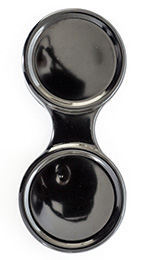
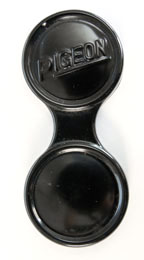
Shinano IA Lens Cap (32 mm)
This lens cap was also found with a Yashima Pigeonflex but the only three others like it that I have seen belong to model IA examples. I am certain that it also originally belonged to a IA:
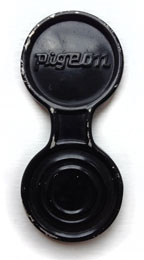 (Image courtesy of Sandu Baciu)
(Image courtesy of Sandu Baciu)
Alfa Optical Co. IB (and possibly I and IC) Lens Cap (32 mm)
This type are commonly found with the Pigeonflex IB, I presume that the IC is the same but I don't know about the I model, the only one found with a lens cap seems to have a generic plain type:
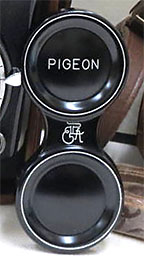 (Detail from larger web image)
(Detail from larger web image)
Tokiwa Seiki ID Lens Cap (36 mm)
This one is similar, although not the same, as on other Tokiwa Seiki made models:
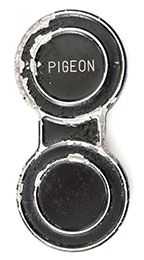
Pigeonflex Ever-ready Cases
Great care needs to be taken assessing the provenance of Pigeonflex ever-ready cases. The Yashima made ones are easy, they don't have a cut-out for the accessory not fitted to Yashima models but they do have a cut-out for the side flash sync - all the others are front sync. There are many more Yashima made Pigeonflexes than the others and therefore there are many more Yashima cases. There is plenty of evidence of late Yashima Pigeonflexes fitted with early cases and vice versa - people replace cases with what they can find. Similarly, there is some evidence of Yashima cases being used for the other models. An immediate giveaway is an accessory shoe cut-out together with a side synch hole on a camera with front sync. No matter how neatly done, close examination will reveal that the shoe cut-out is not original. I too was originally fooled into thinking that some Shinano examples used a case very similar to the late Yashima (11 bar) type below but I'm fairly certain that is incorrect, they are more likely to be modified Yashima cases.
Yashima Cases
First type with 2 rectangles, middle type with 6 bars and last version with 11 bars and no longer featuring the 3 rivets on top for the now absent inside pocket/reinforcing piece (I have no idea about what its purpose is):
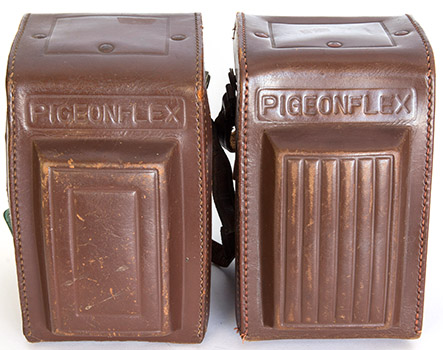
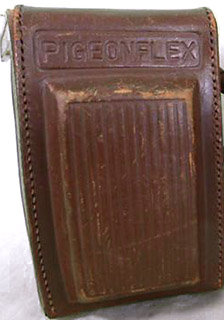
(Right detail from larger web image)
Shinano IA Case
Whilst I have seen several cases with the Shinano IA model that look like the third case above, I now think that they may be modified Yashima cases. The case type below is found with a couple of the earlier IA examples as well as 2 of the late Excelsior lens type. It is probably the only type offered originally:
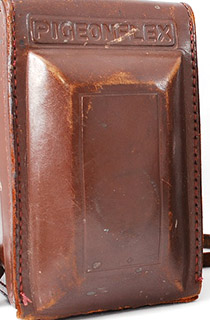 (Detail from larger web image)
(Detail from larger web image)
Alfa Optical Co. I, IB and IC Cases
The case on the left was actually found with a Shinano IA camera but I'm fairly certain that it was only originally offered with what I believe are Alfa Optical Co. models. The type has been found with several earlier Alfa Pigeonflex examples. The example on the right belongs to what might be the 1C model but the same type is also found with later 1 and 1B examples. The style, and particularly the logo in the centre panel, are very similar to other Alfaflex and Cosmoflex models:
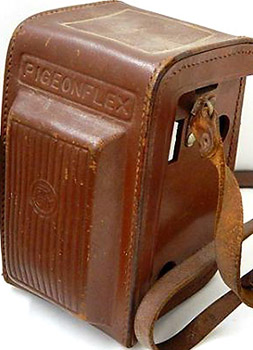
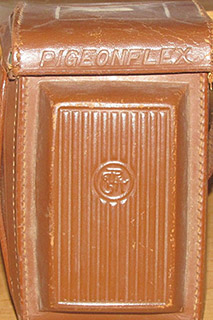 (Detail from larger web images)
(Detail from larger web images)
Tokiwa Seiki ID Case
I have the only (what I believe is) Tokiwa Seiki made Pigeonflex that I have seen. Unfortunately, it didn't come with a case. What the ID case might look like is this one supplied with the Tokiwa Seiki made Soligor Reflex II:
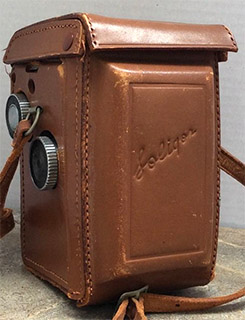 (Detail from larger web image)
(Detail from larger web image)
Pigeon Lens Hoods
Contributor Chris Whelan has collected three different Pigeon lens hoods. These are marked “Pigeon 32”, “Pigeon 35” and “Pigeon 36”. The 32 and 36 use a plain font, the 35 mimics the style found on the variants of the Pigeon 35 camera, but not exactly, suggesting that it is for that camera but made by someone else than the camera maker (Shinano). The 32 fits the Yashima Pigeonflex and Shinano Pigeonflex IA. I don't know about the model I and IB/IC but certainly not the ID which has a 36 mm diameter lens bezel. The 35 and 36 hoods came with stepped filter adaptors/reducers which also fit them to 32 mm bezels and the 36 included a set of colour filters, see the Pigeon 35 page, Model IIA. The 32 mm also came with a filter adaptor, this time one side is 32 mm inside measurement and the other is 32 mm outside, i.e. it fits a 32 mm bezel with or without adaptor. Certainly, there is no evidence of Yashima producing lens hoods or other accessories until at least late 1955. Whether Shinano, Alfa Optical Co. or Tokiwa Seiki were responsible for any of these hoods, or whether the Pigeon hoods were separately commissioned by distributor Endō Sashin Yōhin, perhaps from a lens hood specialist, is not something I have formed a view about, although I suspect that the square one marked “Pigeon 35” was mainly intended for its namesake camera and I note that the 32 and 36 are very similar to each other. All three hoods shown fitted to a Yashima Pigeonflex:
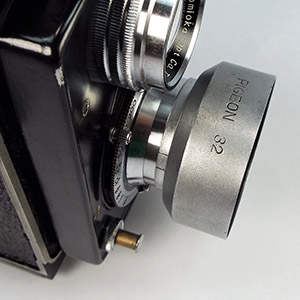
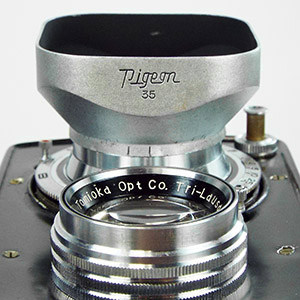
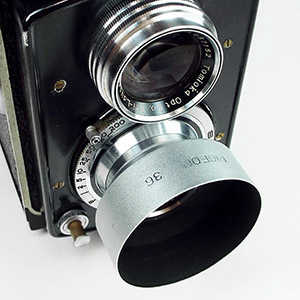
(Images courtesy of Chris Whelan)
.jpg)
.jpg)
.jpg)
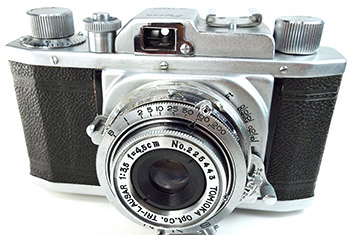
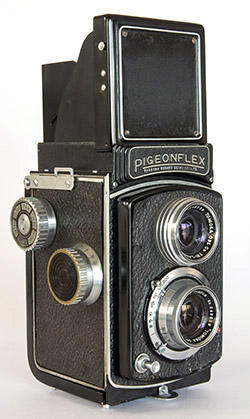
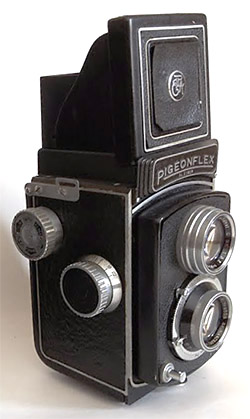
.jpg)
